Location: EU
Moldova’s EU Integration and the Special Case of Transnistria
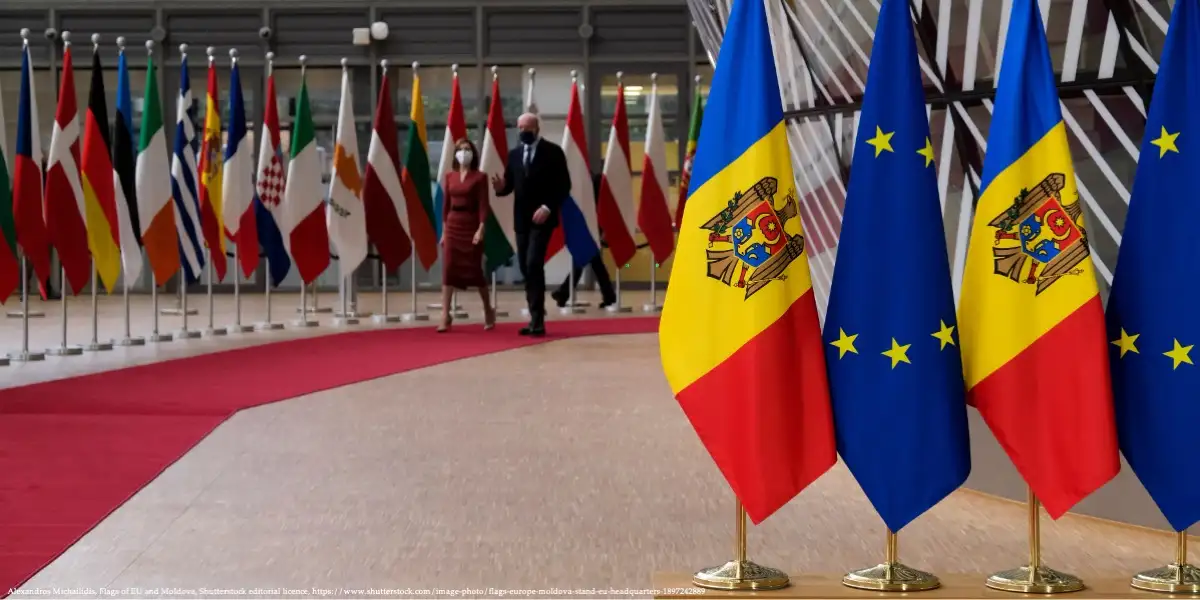
In the shadow of Russia’s invasion of Ukraine, another East European country is actively working to secure its European future. After three years of negotiating cooperation agreements with the European Commission, Moldova finally obtained its EU candidate status and is now on track to join the EU as a member state. However, among many remaining obstacles on the path to full membership, one stands out as especially problematic: the region of Transnistria. The region, officially Pridnestrovian Moldovan Republic, is an internationally unrecognized country and is rather seen as a region with which Russia has “special relations”, including a military presence in the region since 1992. This policy brief provides an overview of the current state of the Transnistrian economy and its relationships with Moldova, the EU, and Russia, arguing that Transnistria’s economy is de facto already integrated into the Moldovan and EU economies. It also points to the key challenges to resolve for a successful integration of Moldova into the EU.
Moldova’s EU Integration: The Moldovan Economy on its Path to EU Accession
On December 14th, 2023, the European Council decided to open accession negotiations with Moldova, recognizing Moldova’s substantial progress when it comes to anti-corruption and de-oligarchisation reforms. The first intergovernmental conference was held on the 25th of June 2024, officially launching accession negotiations (European Council, 2024). On October 20th, 2024, Moldova will hold a referendum on enshrining Moldova’s EU ambitions in the constitution. However, several issues remain to be solved, for Moldova to enter the EU.
With a small and declining population of only about 2.5 million people and a GDP of 16.54 billion US dollars (2023), Moldova remains among the poorest countries in Eastern Europe. In 2023 the GDP per capita was 6600 US dollars in exchange rate terms (substantially higher if using PPP-adjusted measures; World Bank, 2024a). In the last decade, the largest share of its GDP, about 60 percent, stemmed from activities in the services sector, and about 20 and 10 percent from the industrial and agricultural sectors, respectively (Statista, 2024). Despite substantial economic growth in the last decade (3.3 percent on average between 2016 and 2021) and recent reforms (largely under the presidency of Maia Sandu), Moldova remains highly dependent on financial assistance from abroad and remittances, the latter contributing to about 15 – 35 percent of Moldova’s GDP in the last two decades (World Bank, 2024b).
The COVID-19 pandemic and refugee flows caused by Russia’s invasion of Ukraine have only intensified this dependence. Furthermore, these events excavated existing vulnerabilities in the Moldovan economy, such as high inflation and soaring energy and food prices, which depressed households’ disposable incomes and consumption, while war-related uncertainty contributed to weaker investment (World Bank, 2024c).
The Contested Region of Transnistria – Challenge for Moldova’s EU Integration
In addition to Moldova’s economic challenges, the country also faces a particular and unusual problem; it does not fully control its territory. The Transnistrian region in the North-West of the country (at the South-Western border of Ukraine) constitutes about 12 percent of Moldova’s territory. The region has a population of about 350 000 people, mostly Russian-speaking Moldovans, Russians, and Ukrainians.
Following the breakup of the Soviet Union, a movement for self-determination for the Pridnestrovian Moldavian Republic resulted in a self-declaration of its independence on the 2nd of September 1990. More specifically, the alleged suppression of the Russian language and threats of unification between Moldova and Romania were the main stated reasons for the Transnistrian movement for self-determination, which in turn led to the civil armed conflict in 1992 and a following ceasefire agreement (Government of Republic of Moldova, 1992). The main points of the agreement concern the stationing of Russia’s 14th Army in Transnistria, the establishment of a demilitarized security zone, and the removal of restrictions on the movement of people, goods, and services between Moldova and Transnistria. As of 1992, Transnistria is de-facto an entity under “Russia’s effective control” (Roșa, 2021).
Over the years, the interpretations of the conflict have become more controversial, ranging from the local elite’s perspectives to assertions of an entirely artificial conflict fueled by malign Russian influence (Tofilat and Parlicov, 2020).
Notably, the Moldovan government has never officially recognized Transnistria as an occupied territory (see Article 11 of the Moldovan constitution stating “The Republic of Moldova – a Neutral State (1) The Republic of Moldova proclaims its permanent neutrality. (2) The Republic of Moldova shall not allow the dispersal of foreign military troops on its territory” (Constitute, 2024)).
Furthermore, the European Council’s official recognition of Transnistria as an “occupied territory” on March 15, 2022, underscores the EU’s stance on the matter and highlights Russia’s pivotal role in providing political, economic, and military support to Transnistria (PACE, 2022).
The Transnistrian Economy: Main Indicators and Weaknesses
Despite Russia’s central role in Transnistria, the region’s economy is, in practice, substantially integrated into the Moldovan and EU economies. This fact should be considered at various levels of decision-making when discussing Moldova’s EU accession.
As depicted in Figure 1, economic activity in Transnistria has been quite “stable” in the last decade. GDP per capita has remained around 2000 US dollars, 2,5 times lower than Moldova’s GDP per capita in 2021.
Figure 1. Moldovan and Transnistrian GDP per capita, in thousand USD
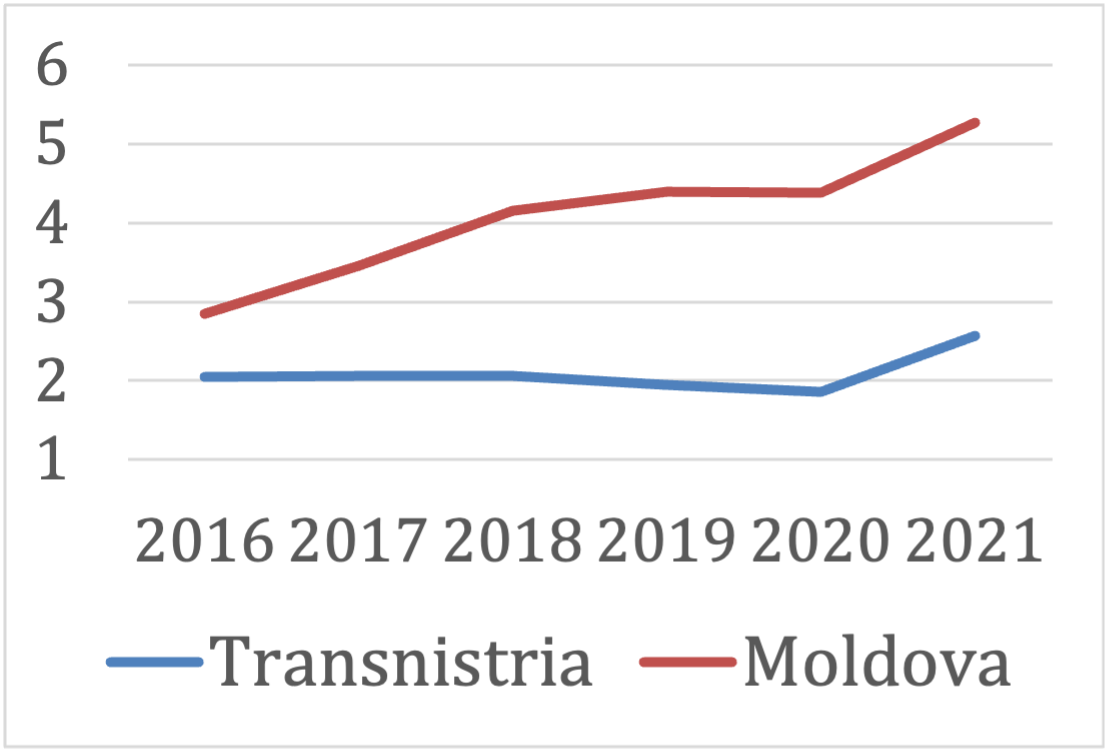
Source: Data from World Bank, 2024; Pridnestrovian Republican Bank, 2024a. Note: since 2022 the Pridnestrovian Republican Bank has suspended publishing official statistics on macroeconomic indicators.
However, one must be careful when estimating and interpreting Transnistrian economic indicators in dollar terms. The local currency is the Transnistrian ruble which is not recognized anywhere in the world except in Russia. Its real value is thus highly uncertain as there is no market for this currency. Moreover, only Russian banks are authorized to open accounts and conduct transactions in the currency, demonstrating yet another significant weakness for Transnistria as a potential independent state, particularly given the current global ban on most Russian banks. As such, the official exchange rate for US dollars should be taken with a grain of salt. At the same time, there are no alternative statistics as the Pridnestrovian Republican Bank is the only source for relevant data on Transnistria.
Another distinctive feature of Transnistria is the substantial reliance on remittances from abroad (see Figure 2). In 2021, remittances amounted to 143.7 million US dollars, constituting 15.5 percent of GDP in 2021 (if relying on the official exchange rate for US dollars, as published by the Pridnestrovian Republican Bank).
Figure 2. Remittances to/from Transnistria, in million USD

Source: Data from the Pridnestrovian Republican Bank (2024b). Note: CIS denotes the Commonwealth of Independent States and all other countries.
Figure 2 illustrates a notable trend of increasing dependency on remittances in recent years, particularly on remittances originating from CIS countries, chiefly Russia and Ukraine.
In terms of reliance on Russia, this dependency is not a concern when it comes to Transnistria’s exports. Foreign trade data from recent years indicates that the Transnistrian economy no longer relies on exports to Russia. As seen in Figure 3, the share of exports to Russia has been constantly declining since 2014 and amounted to merely 9.2 percent in 2021. At the same time, exports to the EU, Moldova and Ukraine collectively accounted for about 80 percent in 2021. The primary commodities driving Transnistrian exports were metal products, amounting to 337.3 million US dollars in 2021, followed by electricity supplies at 130.1 million US dollars. Additionally, food products and raw materials contributed 87.6 million US dollars to Transnistrian exports in the same period.
Figure 3. Transnistrian exports by destination countries, in percent

Source: Data from the Pridnestrovian Republican Bank Bulletins (2024c).
These figures highlight the significant integration of the Transnistrian economy into the European market and, to some extent, indicate the strong potential to further align in this direction.
The increase in Transnistria’s exports to the EU in recent years can be largely attributed to the implementation of mandatory registration of Transnistrian enterprises in Moldova in 2006 as a prerequisite for engaging in foreign economic activities (EUBAM, 2017). Consequently, Moldova has exercised full control over Transnistrian exports and partial control over its imports since 2006.
However, Transnistria remains reliant on Russia for its imports, particularly in the energy sector. In contrast to the export structure, Russia’s share in Transnistrian imports was significantly larger in 2021. About 45 percent of the imports originated from Russia in 2021, and mostly constituted of fuel and energy goods (447.0 million US dollars) and metal imports (254.3 million US dollars), quite typical for a transition economy.
Figure 4. Transnistrian imports by origin countries, in percent
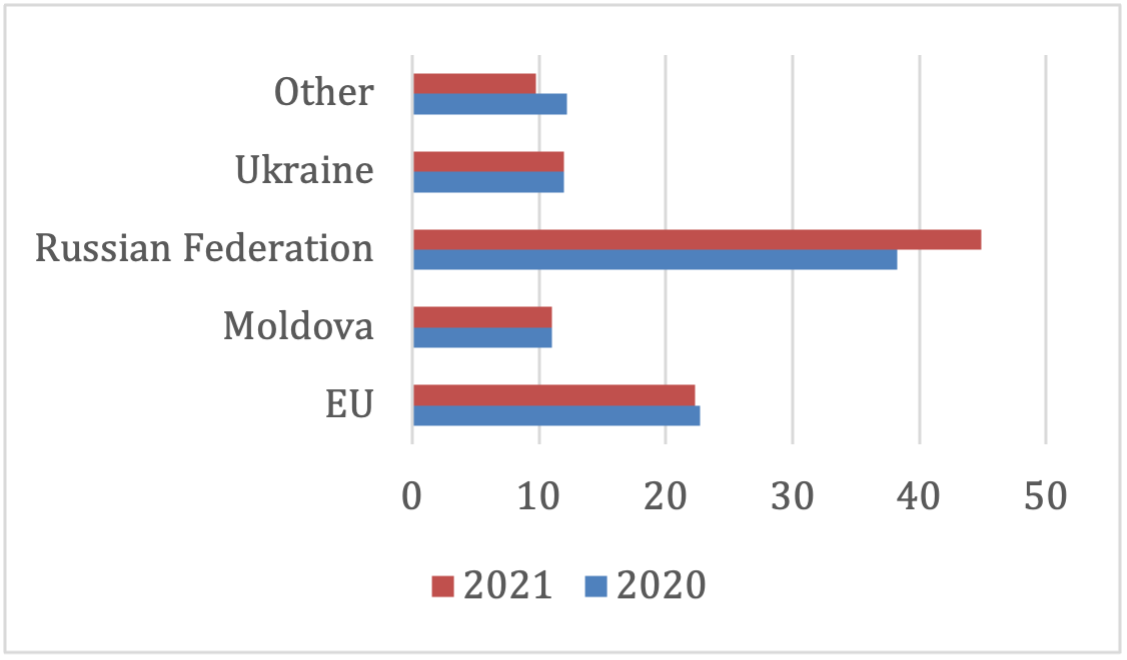
Source: Data from the Pridnestrovian Republican Bank Bulletins (2024c).
Transnistria’s Energy Dependence on Russia
The biggest challenge for Transnistria, as well as for Moldova, is the large fuel and energy dependence on Russia, mostly in the form of natural gas.
For many years, gas has been supplied to Transnistria effectively for free, often in the form of a so-called “gas subsidy” (Roșa, 2021). This gas flows through Transnistria to Moldova, effectively accumulating a gas debt. Typically, Gazprom supplies gas to Moldovagaz, which in turn distributes gas to Moldovan consumers and to Tiraspol-Transgaz in Transnistria. Tiraspol-Transgaz then resell the gas at subsidized tariffs to local Transnistrian households and businesses. This included providing gas to the Moldovan State Regional Power Station, also known as MGRES – the largest power plant in Moldova. MGRES, in turn, exports electricity, further highlighting the interconnectedness of energy distribution between the Transnistrian region and the rest of Moldova.
Figure 5. Export/import of fuel and energy products from/to Transnistria, in million USD

Source: Data from the Pridnestrovian Republican Bank Bulletins (2024c). Note: Data for 2017 and 2018 unavailable.
The revenue generated from energy exports to Moldova has been deposited into a so-called special gas account and subsequently channeled directly into the Transnistrian budget in the form of loans from Tiraspol-Transgaz. In this way the Transnistrian government has covered more than 30 percent of their total budgetary expenditures over the last ten-year period. This further points to Transnistria’s’ fiscal inefficiencies and highlights its precarious dependency on gas from the Russian Federation.
In the last few years there have however been repeated disruptions in the gas supply and continuous disputes about prices and how much Moldovagaz owes Gazprom. De jure Tiraspol-Transgaz operates as a subsidiary of Moldovagaz, but de facto its assets were effectively nationalized by the separatist authorities in Transnistria (Tofilat and Parlicov, 2020). These unclarities has led to multiple conflicts over who owes the built-up gas debt. Given the ownership structure the debt is often seen as “Moldovan debt to Russia” (see e.g., Miller, 2023), albeit created by Transnistrian authorities. According to Gazprom, the outstanding amount owed by Moldovagaz to Gazprom stood at approximately 8 billion USD at the end of 2019 (Gazprom, 2024). This corresponds to about 7 times of Transnistria’s GDP. The Moldavian assessment of the debt is about two orders of magnitude lower (Gotev, 2023).
The disagreement on the debt amount was the official reason for the gas supply to be drastically reduced in October 2022. From December 2022 to March 2023, Russia’s Gazprom supplied gas only to Transnistria and it was not until March 2023 that supplies to the rest of Moldova were resumed. Since then, there have been shifts back and forth with Moldova mainly buying gas from Moldovan state-owned Energocom, which imports gas from suppliers other than Gazprom (Całus, 2023; Tanas, 2023). Understanding all turns and events is at times challenging due to lack of transparency in dealings.
Currently, despite Gazprom’s debt claims, the entirety of Transnistria’s gas is still being provided by Russia. While this is a relatively “cheap” investment from the Russian perspective, its impact on Moldova is large, as highlighted by Tofilat and Parlicov (2020) “the bottomline costs for Russia with maintaining Transnistria as its main instrument of influence in Moldova was at most USD 1 billion—not too expensive for twenty-seven years of influence in a European country of 3 million people”.
Corruption in Transnistria – Who is the Real “Sheriff”?
Another obstacle hindering a resolution of the Transnistrian conflict is the near complete monopoly of political and economic power held by Transnistria’s former President Igor Smirnov (1991-2011), through his strong ties to the Sheriff corporation. The corporation, established in 1993 by two former members of Transnistria’s “special services” (Ilya Kazmaly and Victor Gushan), was enabled by Transnistria’s former president, Igor Smirnov. For instance, the Sheriff company was exempt from paying customs duties and was permitted to monopolize trade, oil, and telecommunications in Transnistria. In return, the company supported Smirnov’s party during his presidency. For more on the conflict between Transnistria’s power clans and their relationships with Russia, see Hedenskog and Roine (2009) and Wesolowsky (2021).
The Sheriff company encompasses supermarkets, gas stations, construction firms, hotels, a mobile phone network, bakeries, a distillery, and a mini media empire comprising radio and TV stations. Presently, the company is reported to exert control over approximately 60 percent of the region’s economy (Wesolowsky, 2021).
A straightforward illustration of Sheriff’s political influence is the establishment of the Sheriff football team. For the team, Victor Gushan constructed the Sheriff sports complex, the largest football stadium in Moldova, accommodating
12 746 spectators. This investment in sports infrastructure is notable, especially considering that the total population of Transnistria is only approximately 350 000, and that the region is fairy poor. A similar example concerns the allocation of a land plot of 6.4 hectares to the company “to expand the construction of sports complex for long-term use under a simplified privatization procedure” signed directly by the former president.
While these details may seem peripheral to broader problems, they illustrate how some vested interests in the Transnistrian region may not be keen to change towards a society based on the rule-of-law, increased transparency and a market-oriented economy.
Moldova’s Options for Resolving the Transnistrian Conflict in EU Integration
As Moldova grapples with both the consequences of the ongoing conflict in Ukraine and the prolonged “frozen” conflict with Transnistria, its economy remains vulnerable. With the recent attainment of EU candidate status, it’s essential for the Moldovan government to map out ways to solve the conflict despite strong interest from powerful political and economic groups in preserving the status quo.
While the perspectives of resolving the Transnistrian conflict obviously hinge on Russian troops withdrawing from the region, Moldova would also need to address a wide range of economic issues. The Transnistrian economy faces numerous critical structural challenges including a persistent negative foreign trade balance, an unsustainable banking system, and pervasive corruption. Notably, the dominant oligarchic entity, the Sheriff company, exercises monopolistic political and economic influence, striving to preserve the status quo for Transnistria. The obvious unviability of the local currency due to its artificial nature and a complete dependency on Russia’s banking system are additional challenges to be solved for Moldova to be able to integrate Transnistria properly into its economy. Therefore, introducing additional measures such as restricting access to remittances in Transnistria, and imposing personal sanctions on elite groups could help Moldova in establishing economic control over the region.
Furthermore, while the Transnistrian region de-facto has strong economic ties with the Moldovan and European markets in terms of exports, its heavy reliance on Russian gas imports remains a significant vulnerability.
When integrating Transnistria and severing its ties with Russia, Moldova would also need to resolve the issues arising from its reliance on the electricity produced at MGRES using subsidized Russian gas. Natural gas bought at market prices would make Moldovan electricity highly costly, presenting financial challenges to Moldova, and effectively destroying the competitive advantage and important source of revenue in the Transnistrian region. Moreover, alternative electricity routes to Moldova are yet to be completed (with an estimated cost of approximately 27 million EUR).
These and other issues need to be dealt with for a successful Moldovan transition into the EU. Although these challenges are highly important from a Moldovan point of view, and even more so from a Transnistrian perspective, it should be emphasized that these issues are, in economic terms, relatively small for the EU. Given that the EU has opened the way for Moldovan accession, it should be ready to step up financially to help Moldova solve these issues and stay on the membership path.
References
- Całus, K. (2023, June 15). Moldova: diversifying supplies and curbing Gazprom’s influence. OSW Centre for Eastern Studies. https://www.osw.waw.pl/en/publikacje/analyses/2023-06-15/moldova-diversifying-supplies-and-curbing-gazproms-influence
- Constitute. (2024). Constitution of Moldova (Republic of) 1994 (revision 2016). Https://www.constituteproject.org/constitution/Moldova_2016
- European Council. (2024, June 25). EU opens accession negotiations with Moldova. https://neighbourhood-enlargement.ec.europa.eu/news/eu-opens-accession-negotiations-moldova-2024-06-25_en
- European Parliament. (2022, June 23). Grant EU candidate status to Ukraine and Moldova without delay. https://www.europarl.europa.eu/news/en/press-room/20220616IPR33216/grant-eu-candidate-status-to-ukraine-and-moldova-without-delay-meps-demand
- European Union Border Assistance Mission to Republic of Moldova and Ukraine (EUBAM). (2017). ENPI 2008 C2008 3821 RAP East EUBAM 6. https://neighbourhood-enlargement.ec.europa.eu/system/files/2017-03/enpi_2008_c2008_3821_rap_east_eubam_6.pdf
- Gazprom. (2024). Gazprom financial report for Q4/2019. https://www.gazprom.ru/f/posts/77/885487/gazprom-ifrs-2019-12m-ru.pdf
- Gotev, G. (2023, September 7). Moldova puts its debt to Gazprom at $8.6 million, Russia disagrees. EURACTIV. https://www.euractiv.com/section/energy-environment/news/moldova-puts-its-debt-to-gazprom-at-8-6-million-russia-disagrees/
- Government of Republic of Moldova. (1992, July 21). Agreement on Principles of Peaceful Settlement of the Armed Conflict in the Transnistrian Region of Moldovan Republic. https://gov.md/sites/default/files/1992-07-21-ru-moscow-agr_on_principles_of_peaceful_settlem.pdf
- Hedenskog, J., & Roine, J. (2009). Transnistrien. En Ekonomisk och Säkerhetspolitisk Analys. Utrikesdepartementet/Ministry of Foreign Affairs. Sweden. Stockholm, 40 p.
- Leontiev, L. (2022, March 25). Big, But Distant Dreams. Political and Legal Implications of Moldova’s Quest for EU Membership. The Review of Democracy. https://revdem.ceu.edu/2022/03/25/big-but-distant-dreams-political-and-legal-implications-of-moldovas-quest-for-eu-membership/
- Miller, M. (2023, September 7). Independent Audit of Gazprom’s Debt Claims Against Moldovagaz. U.S. Embassy in Moldova. https://md.usembassy.gov/independent-audit-of-gazproms-debt-claims-against-moldovagaz/
- Parliamentary Assembly of the Council of Europe (PACE). (2022, March 15). Consequences of the Russian Federation’s aggression against Ukraine. https://pace.coe.int/en/files/29885/html
- Pridnestrovian Republican Bank. (2024a). Main macroeconomic parameters of PMR. https://www.cbpmr.net/content.php?Id=13&lang=ru
- Pridnestrovian Republican Bank (2024b). Remittances. https://www.cbpmr.net/content.php?Id=110&lang=ru
- Pridnestrovian Republican Bank (2024c). Pridnestrovian Republican Bank Bulletins. https://www.cbpmr.net/content.php?Id=28&lang=ru
- Racz, A. (2016, April 8). The Frozen Conflicts of the EU’s Eastern Neighbourhood and Their Impact on the Respect of Human Rights. European Parliament Think Tank. https://www.europarl.europa.eu/thinktank/en/document/EXPO_STU(2016)578001
- Roșa, V. (2021, October 18). The Transnistrian Conflict: 30 Years Searching for a Settlement. SCEEUS Reports on Human Rights and Security in Eastern Europe No.4. https://sceeus.se/publikationer/the-transnistrian-conflict-30-years-searching-for-a-settlement/
- Statista. (2024). Moldova: Distribution of gross domestic product (GDP) across economic sectors from 2012 to 2022. https://www.statista.com/statistics/513314/moldova-gdp-distribution-across-economic-sectors/
- Tanas, A. (2023, March 21). Moldova resumes gas purchases from Russia’s Gazprom -Moldovagaz head. Reuters. https://www.reuters.com/business/energy/moldova-resumes-gas-purchases-russias-gazprom-moldovagaz-head-2023-03-21/
- Tofilat, S., & Parlicov, V. (2020, August 14). Russian Gas and the Financing of Separatism in Moldova. The Kremlin’s Influence Quarterly #2. https://www.4freerussia.org/russian-gas-and-the-financing-of-separatism-in-moldova/
- Wesolowsky, T. (2021, October 18). The Shadow Business Empire Behind the Meteoric Rise of Sheriff Tiraspol. RadioFreeEurope. https://www.rferl.org/a/moldova-sheriff-tiraspol-murky-business/31516518.html
- World Bank. (2024a). Data. Moldova. https://data.worldbank.org/indicator/NY.GDP.PCAP.PP.CD?Locations=MD
- World Bank. (2024b). Personal remittances, received (% of GDP) – Moldova. https://data.worldbank.org/indicator/BX.TRF.PWKR.DT.GD.ZS?Locations=MD
- World Bank. (2024c). Moldova Overview. https://www.worldbank.org/en/country/moldova/overview
Disclaimer: Opinions expressed in policy briefs and other publications are those of the authors; they do not necessarily reflect those of the FREE Network and its research institutes.
Gender Gap in Life Expectancy and Its Socio-Economic Implications
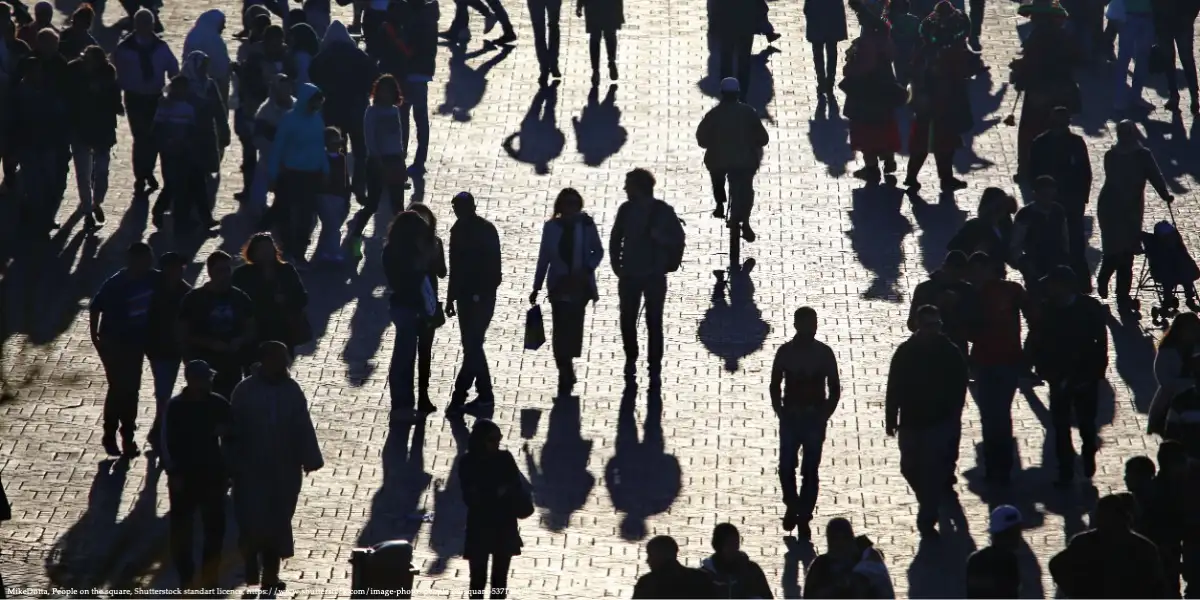
Today women live longer than men virtually in every country of the world. Although scientists still struggle to fully explain this disparity, the most prominent sources of this gender inequality are biological and behavioral. From an evolutionary point of view, female longevity was more advantageous for offspring survival. This resulted in a higher frequency of non-fatal diseases among women and in a later onset of fatal conditions. The observed high variation in the longevity gap across countries, however, points towards an important role of social and behavioral arguments. These include higher consumption of alcohol, tobacco, and fats among men as well as a generally riskier behavior. The gender gap in life expectancy often reaches 6-12 percent of the average human lifespan and has remained stubbornly stable in many countries. Lower life expectancy among men is an important social concern on its own and has significant consequences for the well-being of their surviving partners and the economy as a whole. It is an important, yet under-discussed type of gender inequality.
Country Reports
| Belarus Country Report | FROGEE POLICY BRIEF |
| Georgia Country Report | FROGEE POLICY BRIEF |
| Latvia Country Report | FROGEE POLICY BRIEF |
| Poland Country Report | FROGEE POLICY BRIEF |
Gender Gap in Life Expectancy and Its Socio-Economic Implications
Today, women on average live longer than men across the globe. Despite the universality of this basic qualitative fact, the gender gap in life expectancy (GGLE) varies a lot across countries (as well as over time) and scientists have only a limited understanding of the causes of this variation (Rochelle et al., 2015). Regardless of the reasons for this discrepancy, it has sizable economic and financial implications. Abnormal male mortality makes a dent in the labour force in nations where GGLE happens to be the highest, while at the same time, large GGLE might contribute to a divergence in male and female discount factors with implications for employment and pension savings. Large discrepancies in life expectancy translate into a higher incidence of widowhood and a longer time in which women live as widows. The gender gap in life expectancy is one of the less frequently discussed dimensions of gender inequality, and while it clearly has negative implications for men, lower male longevity has also substantial negative consequences for women and society as a whole.
Figure A. Gender gap in life expectancy across selected countries

Source: World Bank.
The earliest available reliable data on the relative longevity of men and women shows that the gender gap in life expectancy is not a new phenomenon. In the middle of the 19th century, women in Scandinavian countries outlived men by 3-5 years (Rochelle et al., 2015), and Bavarian nuns enjoyed an additional 1.1 years of life, relative to the monks (Luy, 2003). At the beginning of the 20th century, relative higher female longevity became universal as women started to live longer than men in almost every country (Barford et al., 2006). GGLE appears to be a complex phenomenon with no single factor able to fully explain it. Scientists from various fields such as anthropology, evolutionary biology, genetics, medical science, and economics have made numerous attempts to study the mechanisms behind this gender disparity. Their discoveries typically fall into one of two groups: biological and behavioural. Noteworthy, GGLE seems to be fairly unrelated to the basic economic fundamentals such as GDP per capita which in turn has a strong association with the level of healthcare, overall life expectancy, and human development index (Rochelle et al., 2015). Figure B presents the (lack of) association between GDP per capita and GGLE in a cross-section of countries. The data shows large heterogeneity, especially at low-income levels, and virtually no association from middle-level GDP per capita onwards.
Figure B. Association between gender gap in life expectancy and GDP per capita

Source: World Bank.
Biological Factors
The main intuition behind female superior longevity provided by evolutionary biologists is based on the idea that the offspring’s survival rates disproportionally benefited from the presence of their mothers and grandmothers. The female hormone estrogen is known to lower the risks of cardiovascular disease. Women also have a better immune system which helps them avoid a number of life-threatening diseases, while also making them more likely to suffer from (non-fatal) autoimmune diseases (Schünemann et al., 2017). The basic genetic advantage of females comes from the mere fact of them having two X chromosomes and thus avoiding a number of diseases stemming from Y chromosome defects (Holden, 1987; Austad, 2006; Oksuzyan et al., 2008).
Despite a number of biological factors contributing to female longevity, it is well known that, on average, women have poorer health than men at the same age. This counterintuitive phenomenon is called the morbidity-mortality paradox (Kulminski et al., 2008). Figure C shows the estimated cumulative health deficits for both genders and their average life expectancies in the Canadian population, based on a study by Schünemann et al. (2017). It shows that at any age, women tend to have poorer health yet lower mortality rates than men. This paradox can be explained by two factors: women tend to suffer more from non-fatal diseases, and the onset of fatal diseases occurs later in life for women compared to men.
Figure C. Health deficits and life expectancy for Canadian men and women
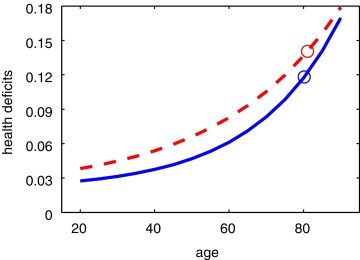
Source: Schünemann et al. (2017). Note: Men: solid line; Women: dashed line; Circles: life expectancy at age 20.
Behavioural Factors
Given the large variation in GGLE, biological factors clearly cannot be the only driving force. Worldwide, men are three times more likely to die from road traffic injuries and two times more likely to drown than women (WHO, 2002). According to the World Health Organization (WHO), the average ratio of male-to-female completed suicides among the 183 surveyed countries is 3.78 (WHO, 2024). Schünemann et al. (2017) find that differences in behaviour can explain 3.2 out of 4.6 years of GGLE observed on average in developed countries. Statistics clearly show that men engage in unhealthy behaviours such as smoking and alcohol consumption much more often than women (Rochelle et al., 2015). Men are also more likely to be obese. Alcohol consumption plays a special role among behavioural contributors to the GGLE. A study based on data from 30 European countries found that alcohol consumption accounted for 10 to 20 percent of GGLE in Western Europe and for 20 to 30 percent in Eastern Europe (McCartney et al., 2011). Another group of authors has focused their research on Central and Eastern European countries between 1965 and 2012. They have estimated that throughout that time period between 15 and 19 percent of the GGLE can be attributed to alcohol (Trias-Llimós & Janssen, 2018). On the other hand, tobacco is estimated to be responsible for up to 30 percent and 20 percent of the gender gap in mortality in Eastern Europe and the rest of Europe, respectively (McCartney et al., 2011).
Another factor potentially decreasing male longevity is participation in risk-taking activities stemming from extreme events such as wars and military activities, high-risk jobs, and seemingly unnecessary health-hazardous actions. However, to the best of our knowledge, there is no rigorous research quantifying the contribution of these factors to the reduced male longevity. It is also plausible that the relative importance of these factors varies substantially by country and historical period.
Gender inequality and social gender norms also negatively affect men. Although women suffer from depression more frequently than men (Albert, 2015; Kuehner, 2017), it is men who commit most suicides. One study finds that men with lower masculinity (measured with a range of questions on social norms and gender role orientation) are less likely to suffer from coronary heart disease (Hunt et al., 2007). Finally, evidence shows that men are less likely to utilize medical care when facing the same health conditions as women and that they are also less likely to conduct regular medical check-ups (Trias-Llimós & Janssen, 2018).
It is possible to hypothesize that behavioural factors of premature male deaths may also be seen as biological ones with, for example, risky behaviour being somehow coded in male DNA. But this hypothesis may have only very limited truth to it as we observe how male longevity and GGLE vary between countries and even within countries over relatively short periods of time.
Economic Implications
Premature male mortality decreases the total labour force of one of the world leaders in GGLE, Belarus, by at least 4 percent (author’s own calculation, based on WHO data). Similar numbers for other developed nations range from 1 to 3 percent. Premature mortality, on average, costs European countries 1.2 percent of GDP, with 70 percent of these losses attributable to male excess mortality. If male premature mortality could be avoided, Sweden would gain 0.3 percent of GDP, Poland would gain 1.7 percent of GDP, while Latvia and Lithuania – countries with the highest GGLE in the EU – would each gain around 2.3 percent of GDP (Łyszczarz, 2019). Large disparities in the expected longevity also mean that women should anticipate longer post-retirement lives. Combined with the gender employment and pay gap, this implies that either women need to devote a larger percentage of their earnings to retirement savings or retirement systems need to include provisions to secure material support for surviving spouses. Since in most of the retirement systems the value of pensions is calculated using average, not gender-specific, life expectancy, the ensuing differences may result in a perception that men are not getting their fair share from accumulated contributions.
Policy Recommendations
To successfully limit the extent of the GGLE and to effectively address its consequences, more research is needed in the area of differential gender mortality. In the medical research dimension, it is noteworthy that, historically, women have been under-represented in recruitment into clinical trials, reporting of gender-disaggregated data in research has been low, and a larger amount of research funding has been allocated to “male diseases” (Holdcroft, 2007; Mirin, 2021). At the same time, the missing link research-wise is the peculiar discrepancy between a likely better understanding of male body and health and the poorer utilization of this knowledge.
The existing literature suggests several possible interventions that may substantially reduce premature male mortality. Among the top preventable behavioural factors are smoking and excessive alcohol consumption. Many studies point out substantial country differences in the contribution of these two factors to GGLE (McCartney, 2011), which might indicate that gender differences in alcohol and nicotine abuse may be amplified by the prevailing gender roles in a given society (Wilsnack et al., 2000). Since the other key factors impairing male longevity are stress and risky behaviour, it seems that a broader societal change away from the traditional gender norms is needed. As country differences in GGLE suggest, higher male mortality is mainly driven by behaviours often influenced by societies and policies. This gives hope that higher male mortality could be reduced as we move towards greater gender equality, and give more support to risk-reducing policies.
While the fundamental biological differences contributing to the GGLE cannot be changed, special attention should be devoted to improving healthcare utilization among men and to increasingly including the effects of sex and gender in medical research on health and disease (Holdcoft, 2007; Mirin, 2021; McGregor et al., 2016, Regitz-Zagrosek & Seeland, 2012).
References
- Albert, P. R. (2015). “Why is depression more prevalent in women?“. Journal of Psychiatry & Neuroscience, 40(4), 219.
- Austad, S. N. (2006). “Why women live longer than men: sex differences in longevity“. Gender Medicine, 3(2), 79-92.
- Barford, A., Dorling, D., Smith, G. D., & Shaw, M. (2006). “Life expectancy: women now on top everywhere“. BMJ, 332, 808. doi:10.1136/bmj.332.7545.808
- Holden, C. (1987). “Why do women live longer than men?“. Science, 238(4824), 158-160.
- Hunt, K., Lewars, H., Emslie, C., & Batty, G. D. (2007). “Decreased risk of death from coronary heart disease amongst men with higher ‘femininity’ scores: A general population cohort study“. International Journal of Epidemiology, 36, 612-620.
- Kulminski, A. M., Culminskaya, I. V., Ukraintseva, S. V., Arbeev, K. G., Land, K. C., & Yashin, A. I. (2008). “Sex-specific health deterioration and mortality: The morbidity-mortality paradox over age and time“. Experimental Gerontology, 43(12), 1052-1057.
- Luy, M. (2003). “Causes of Male Excess Mortality: Insights from Cloistered Populations“. Population and Development Review, 29(4), 647-676.
- McCartney, G., Mahmood, L., Leyland, A. H., Batty, G. D., & Hunt, K. (2011). “Contribution of smoking-related and alcohol-related deaths to the gender gap in mortality: Evidence from 30 European countries“. Tobacco Control, 20, 166-168.
- McGregor, A. J., Hasnain, M., Sandberg, K., Morrison, M. F., Berlin, M., & Trott, J. (2016). “How to study the impact of sex and gender in medical research: A review of resources“. Biology of Sex Differences, 7, 61-72.
- Mirin, A. A. (2021). “Gender disparity in the funding of diseases by the US National Institutes of Health“. Journal of Women’s Health, 30(7), 956-963.
- Oksuzyan, A., Juel, K., Vaupel, J. W., & Christensen, K. (2008). “Men: good health and high mortality. Sex differences in health and aging“. Aging Clinical and Experimental Research, 20(2), 91-102.
- Regitz-Zagrosek, V., & Seeland, U. (2012). “Sex and gender differences in clinical medicine“. Sex and Gender Differences in Pharmacology, 3-22.
- Rochelle, T. R., Yeung, D. K. Y., Harris Bond, M., & Li, L. M. W. (2015). “Predictors of the gender gap in life expectancy across 54 nations“. Psychology, Health & Medicine, 20(2), 129-138. doi:10.1080/13548506.2014.936884
- Schünemann, J., Strulik, H., & Trimborn, T. (2017). “The gender gap in mortality: How much is explained by behavior?“. Journal of Health Economics, 54, 79-90.
- Trias-Llimós, S., & Janssen, F. (2018). “Alcohol and gender gaps in life expectancy in eight Central and Eastern European countries“. European Journal of Public Health, 28(4), 687-692.
- WHO. (2002). “Gender and road traffic injuries“. World Health Organization.
- WHO. (2024). “Global health estimates: Leading causes of death“. World Health Organization.
- Łyszczarz, B. (2019). “Production losses associated with premature mortality in 28 European Union countries“. Journal of Global Health.
About FROGEE Policy Briefs
FROGEE Policy Briefs is a special series aimed at providing overviews and the popularization of economic research related to gender equality issues. Debates around policies related to gender equality are often highly politicized. We believe that using arguments derived from the most up to date research-based knowledge would help us build a more fruitful discussion of policy proposals and in the end achieve better outcomes.
The aim of the briefs is to improve the understanding of research-based arguments and their implications, by covering the key theories and the most important findings in areas of special interest to the current debate. The briefs start with short general overviews of a given theme, which are followed by a presentation of country-specific contexts, specific policy challenges, implemented reforms and a discussion of other policy options.
Disclaimer: Opinions expressed in policy briefs and other publications are those of the authors; they do not necessarily reflect those of the FREE Network and its research institutes.
Navigating Market Exits: Companies’ Responses to the Russian Invasion of Ukraine
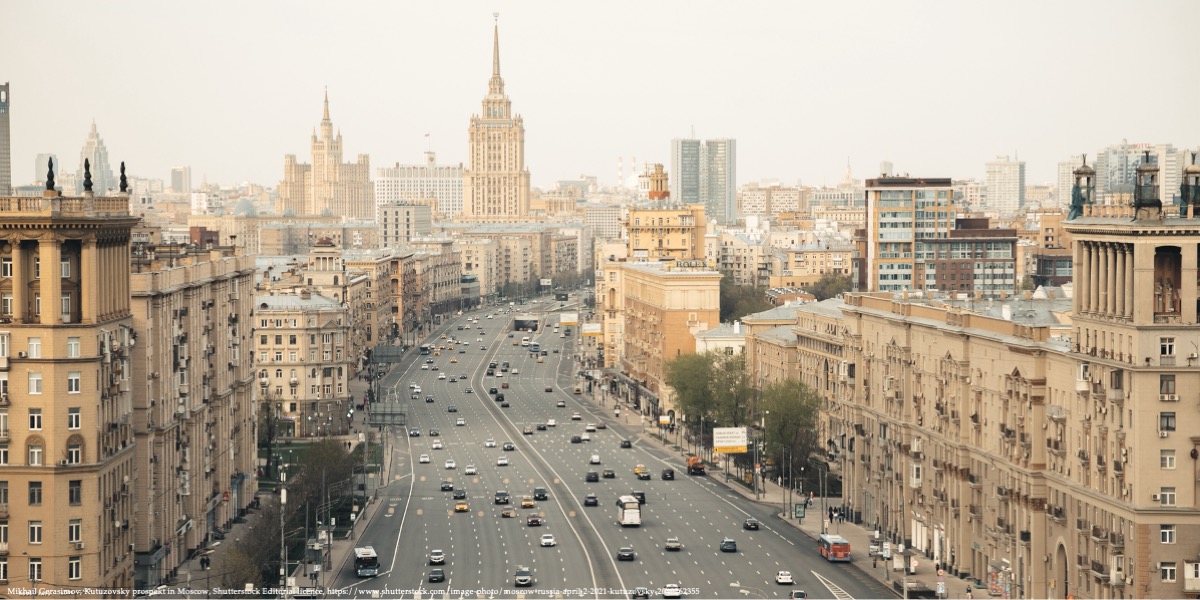
Russia’s invasion of Ukraine on 24 February 2022 led to widespread international condemnation. As governments imposed sanctions on Russian businesses and individuals tied to the war, international companies doing business in Russia came under increasing pressure to withdraw from Russia voluntarily. In the first part of this policy brief, we show what kind of companies decided to leave the Russian market using data collected by the LeaveRussia project. In the second part, we focus on prominent Swedish businesses which announced a withdrawal from Russia, but whose products were later found available in the country by investigative journalists from Dagens Nyheter (DN). We collect the stock prices for these companies when available and show how investors respond to these news.
Business Withdrawal from Russia
The global economy is highly interconnected, and Russia forms an important part. Prior to the invasion, Russia ranked 13th in the world in terms of global goods exports value and 22nd in terms of imports (Schwarzenberg, 2023). In the months following the full-scale invasion of Ukraine, Russia’s imports dropped sharply (about 50 percent according to Sonnenfeld et al., 2022). Before February 24th, Russia’s main trading partners were China, the European Union (in particular, Germany and the Netherlands) and Belarus (as illustrated in Figure 1). While there is some evidence of Russia shifting away from Western countries and towards China following the annexation of Crimea in 2014 and the resulting sanctions, Western democracies still made up about 60 percent of Russia’s trade in 2020 (Schwarzenberg, 2023). In the same year, Sweden’s exports to Russia accounted for 1.4 percent of Sweden’s total goods exports, of which 59 percent were in the machinery, transportation and telecommunications sectors. 1.3 percent of Swedish imports were from Russia (Stockholms Handelskammare, 2022).
Figure 1. Changes in trade with Russia, 2013-2020.
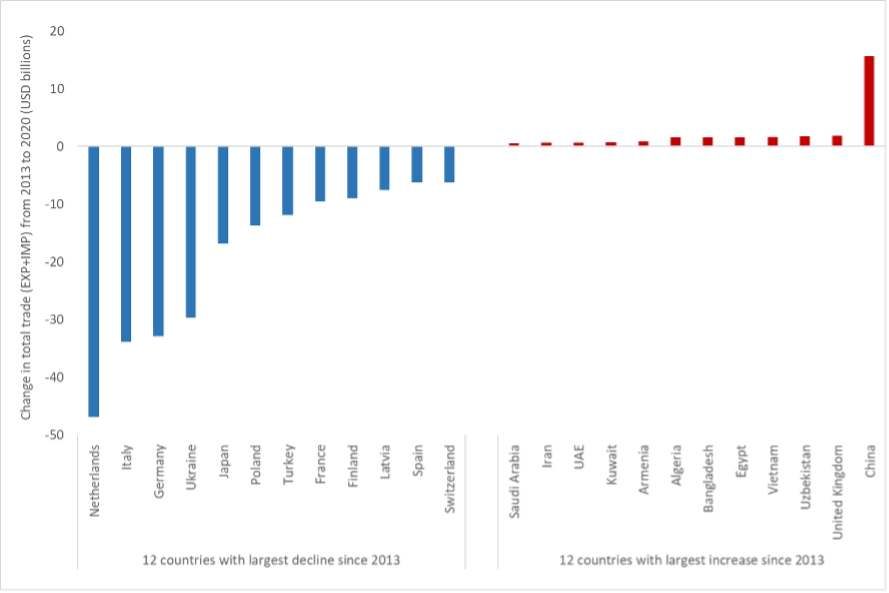
Source: IMF Direction of Trade Statistics, data until 2020. From Lehne (2022).
In response to Russia’s invasion of Ukraine in February 2024, Western governments imposed strict trade and financial sanctions on Russian businesses and individuals involved in the war (see S&P Global, 2024). These sanctions are designed to hamper Russia’s war effort by reducing its ability to fight and finance the war. The sanctions make it illegal for, e.g., European companies to sell certain products to Russia as well as to import select Russian goods (Council of the European Union, 2024). Even though sanctions do not cover all trade with Russia, many foreign businesses have been pressured to pull out of Russia in an act of solidarity. The decision by these businesses to leave is voluntary and could reflect their concerns over possible consumer backlash. It is not uncommon for consumers to put pressure on businesses in times of geopolitical conflict. For instance, Pandya and Venkatesan (2016) find that U.S. consumers were less likely to buy French-sounding products when the relationship between both countries deteriorated.
The LeaveRussia Project
The LeaveRussia project, from the Kyiv School of Economics Institute (KSE Institute), systematically tracks foreign companies’ responses to the Russian invasion. The database covers a selection of companies that have either made statements regarding their operations in Russia, and/or are a large global player (“major companies and world-famous brands”), and/or have been mentioned in relation to leaving/waiting/withdrawing from Russia in major media outlets such as Reuters, Bloomberg, Financial times etc. (LeaveRussia, 2024). As of April 5th, 2024, the list contains 3342 firms, the companies’ decision to leave, exit or remain in the Russian market, the date of their announced action, and company details such as revenue, industry etc. The following chart uses publicly available data from the LeaveRussia project to illustrate patterns in business withdrawals from Russia following the invasion of Ukraine.
Figure 2a shows the number of foreign companies in Russia in the LeaveRussia dataset by their country of headquarters. Figure 2b shows the share of these companies that have announced a withdrawal from Russia by April 2024, by their country of headquarters.
Figure 2a. Total number of companies by country.
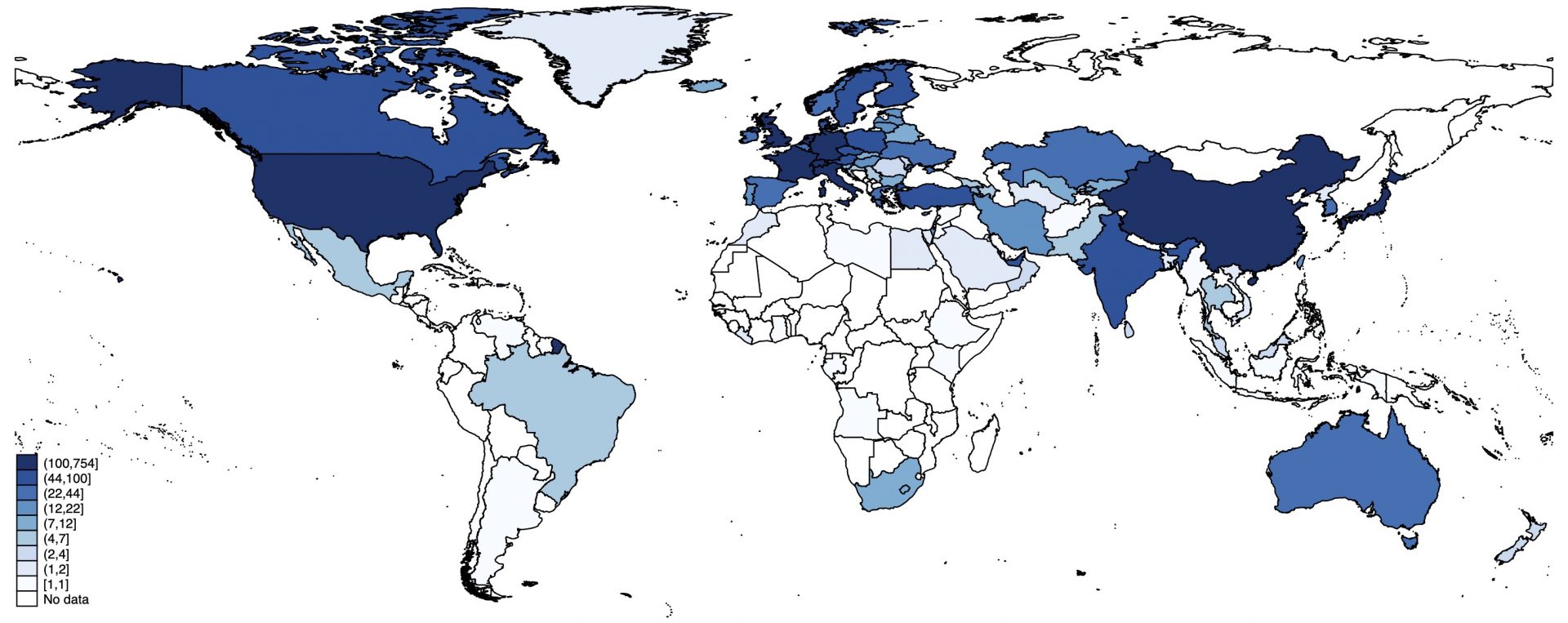
Figure 2b. Share of withdrawals, by country.

Source: Authors’ compilation based on data from the LeaveRussia project and global administrative zone boundaries from Runfola et al. (2020).
Some countries (e.g. Canada, the US and the UK) that had a large presence in Russia prior to the war have also seen a large number of withdrawals following the invasion. Other European countries, however, have seen only a modest share of withdrawals (for instance, Italy, Austria, the Netherlands and Slovakia). Companies headquartered in countries that have not imposed any sanctions on Russia following the invasion, such as Belarus, China, India, Iran etc., show no signs of withdrawing from the Russian market. In fact, the share of companies considered by the KSE to be “digging in” (i.e., companies that either declared they’d remain in Russia or who did not announce a withdrawal or downscaling as of 31st of March 2024) is 75 percent for more than 25 countries, including not only the aforementioned, but also countries such as Argentina, Moldova, Serbia and Turkey.
Withdrawal Determinants
The decision for companies to exit the market may range from consumer pressure to act in solidarity with Ukraine, to companies’ perceived risk from operating on the Russian market (Kiesel and Kolaric, 2023). Out of the 3342 companies in the LeaveRussia project’s database, about 42 percent have, as of April 5th, 2024, exited or stated an intention to exit the Russian market. This number increases only slightly to 49 percent when considering only companies headquartered in democratic (an Economist Intelligence Unit Democracy Index score of 7 or higher) countries within the EU. Figure 3 shows the number of companies that announced their exit from the Russian market, by month. A clear majority of companies announce their withdrawal in the first 6 months following the invasion.
Figure 3. Number of foreign companies announcing an exit from the Russian market, 2022-2024.

Source: Authors’ compilation based on data from the LeaveRussia project.
Similarly to the location of companies’ headquarters, the decision to exit the Russian market varies by industry. Figure 4 a depicts the top 15 industries with the highest share of announced withdrawals from the Russian market among industries with at least 10 companies. Most companies with high levels of withdrawals are found in consumer-sensitive industries such as the entertainment sector, tourism and hospitality, advertising etc.
Figure 4a. Top 15 industries in terms of withdrawal shares.
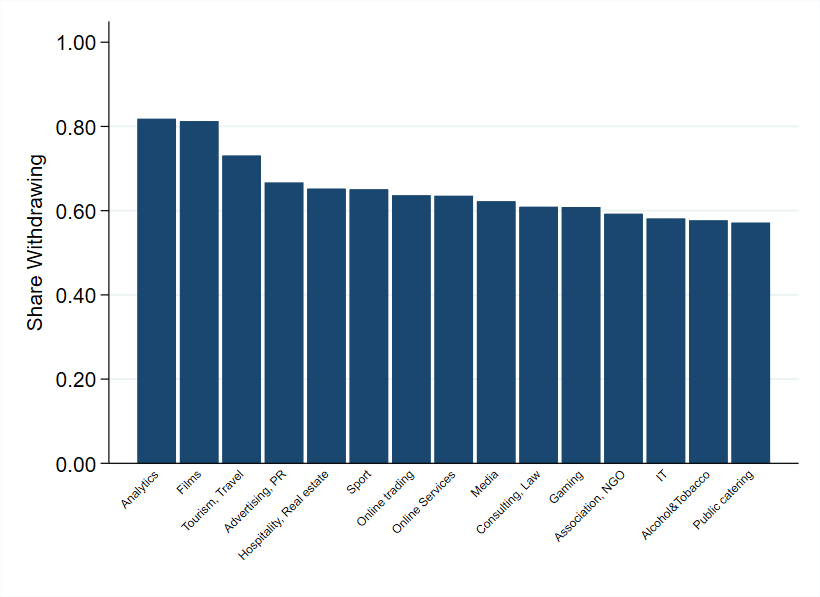
Figure 4b. Bottom 15 industries in terms of withdrawal shares.

Source: Authors’ compilation based on data from the LeaveRussia project.
In contrast, Figure 4b details the industries with the lowest share of companies opting to withdraw from the Russian market. Only around 10 percent of firms in the “Defense” and “Marine Transportation” industries chose to withdraw. Two-thirds of firms within the “Energy, oil and gas” and “Metals and Mining” sectors have chosen to remain in business in Russia following the war in Ukraine.
Several sectors have been identified as crucial in supplying the Russian military with necessary components to sustain their military aggression against Ukraine, mainly electronics, communications, automotives and related categories. We find that many of these sectors are among those with the lowest share of companies withdrawing from Russia. Companies for which Russia constitute a large market share have more to lose from exiting than others. Another reason for not exiting the market relates to the current legal hurdles of corporate withdrawal from Russia (Doherty, 2023). Others may simply not have made public announcements or operate within an industry dominated by smaller companies that are not on the radar of the LeaveRussia project. Nonetheless, Bilousova et al. (2024) detail that products from companies within the sanction’s coalition continue to be found in Russian military equipment destroyed in Ukraine. This is due to insufficient due diligence by companies as well as loopholes in the sanctions regime such as re-exporting via neighboring countries, tampering with declaration forms or challenges in jurisdictional enforcement due to lengthy supply chains, among others. (Olofsgård and Smitt Meyer, 2023).
And Those Who Didn’t Leave After All
The data from the LeaveRussia project details if and when foreign businesses announce that they will leave Russia. However, products from companies that have announced a departure from the Russian market continue to be found in the country, including in military components (Bilousova, 2024). In autumn 2023, investigative journalists from the Swedish newspaper Dagens Nyheter exposed 14 Swedish companies whose goods were found entering Russia, in most cases contrary to the companies’ public claims (Dagens Nyheter, 2023; Tidningen Näringslivet, 2023). For this series of articles, the journalists used data from Russian customs and verified it with information from numerous Swedish companies, covering the time period up until December 2022. This entailed reviewing thousands of export records from Swedish companies either directly to Russia or via neighboring countries such as Armenia, Kazakhstan, and Uzbekistan. All transactions mentioned in the article series have been confirmed with the respective companies, who were also contacted by DN prior to publication (Dagens Nyheter, 2023b). DNs journalists also acted as businessmen, interacting with intermediaries in Kazakhstan and Uzbekistan, exposing re-routing of Swedish goods from a company stated to have cut all exports to Russia in the wake of the invasion (Dagens Nyheter, 2023d).
For Sweden headquartered companies exposed in DN and that are traded on the Swedish Stock Exchange, we collect their stock prices and trading volume. Our data includes information on each stock’s average price, turnover, number of trades by date from around the date of the DN publications as well as the date of each company’s prior public announcement of exiting Russia. Table 1 details the companies who were exposed of doing direct or indirect business with Russia by DN and who had announced an exit from the Russian market previously. In their article series, DN also shows that goods from the following companies entered Russia; AriVislanda, Assa Abloy, Atlas Copco, Getinge, Scania, Securitas Tetra Pak, and Väderstad. Most of the companies exposed by DN operate within industries displaying low withdrawal shares.
Table 1. Select Swedish companies’, time of exit announcement and exposure in Dagens Nyheter and stock names.
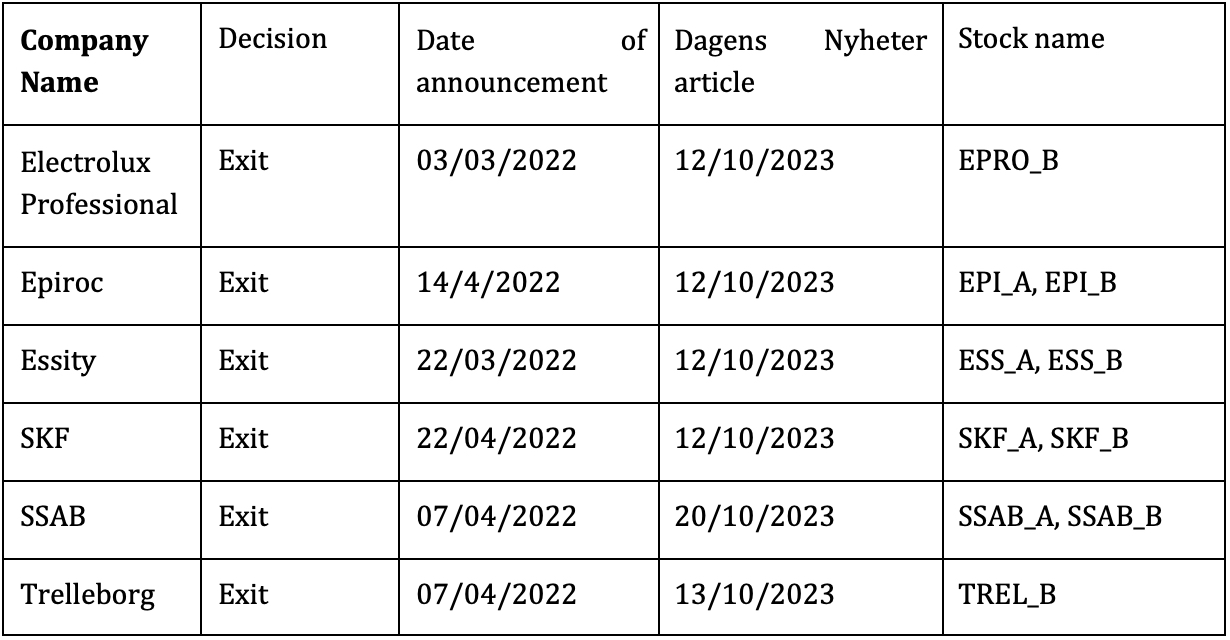
Source: The LeaveRussia project, 2023; Dagens Nyheter, 2023b, 2023c, 2023d. Note: The exit statements have been verified through companies’ press statements and/or reports when available. For Epiroc, the claim has been verified via a previous Dagens Nyheter article (Dagens Nyheter, 2023a).
In Figure 5, we show the average stock price and trades-weighted average stock price of the Swedish companies in Table 1 around the time when the companies announced that they are leaving Russia.
Figure 5. Average stock price of companies in Table 1 around Russian exit announcements.
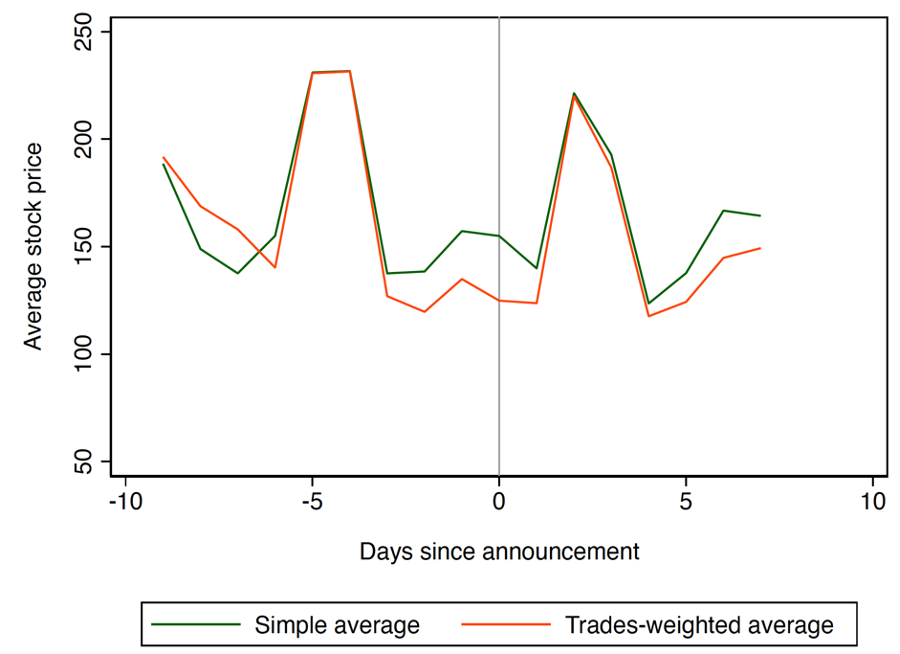
Source: Author’s compilation based on data from Nasdaq Nordic.
There appears to be an immediate increase in stock prices after firms announced their exit from the Russian market. Stock prices, however, reverse their gains over the next couple of days. In general, stock prices are volatile, and we also see similar-sized movements immediately before the announcement. Due to this volatility and the fact that we cannot rule out other shocks impacting these stock prices at the same time, it is difficult to attribute any movements in the stock prices to the firms’ decisions to leave Russia.
The academic evidence on investors’ reactions to firms divesting from Russia is mixed. Using a sample of less than 300 high-profile firms with operations in Russia compiled by researchers at the Yale Chief Executive Leadership Institute, Glambosky and Peterburgsky (2022) find that firms that divest within 10 days after the invasion experience negative returns, but then recover within a two-week period. Companies announcing divesting at a later stage do not experience initial stock price declines. In contrast, Kiesel and Kolaric (2023) use data from the LeaveRussia project to find positive stock price returns to firms’ announcements of leaving Russia, while there appears to be no significant investor reaction to firms’ decisions to stay in Russia.
When considering the effect from DN’s publications, the picture is almost mirrored, with the simple and trades-weighted average stock prices dipping in the days following the negative media exposure before not only recovering, but actually increasing. Similar caveats apply to the interpretation of this chart. In addition, the DN publication occurred shortly after the Hamas attacks on Israel on October 7 and Israel’s subsequent war on Gaza. While conflict and uncertainty typically dampen the stock market, the events in the Middle East initially caused little reaction on the stock market (Sharma, 2023).
Figure 6. Average stock price for companies listed in Table 1 around the time of DN exposure.

Source: Author’s compilation based on data from Nasdaq Nordic.
Discussion
As discussed in Becker et al. (2024), creating incentives and ensuring companies follow suit with the current sanctions’ regime should be a priority if we want to end Russia’s war on Ukraine and undermine its wider geopolitical ambitions. Nevertheless, Bilousova et al. (2024), and Olofsgård and Smitt Meyer (2023), highlight that there is ample evidence of sanctions evasions, including for products that are directly contributing to Russia’s military capacity. Even in countries that have a strong political commitment to the sanctions’ regime, enforcement is weak. For instance, in Sweden, it is not illegal to try and evade sanctions according to the Swedish Chamber of Commerce (2024). There is little coordination between the numerous law enforcement agencies that are responsible for sanction enforcement and there have been very few investigations into sanctions violations.
Absent effective sanctions enforcement and for the many industries not covered by sanctions, can we rely on businesses to put profits second and voluntarily withdraw from Russia? Immediately after the start of Russia’s invasion of Ukraine, as news stories about the brutality of the war proliferated, many international companies did announce that they will be leaving Russia. However, a more systematic look at data collected by the LeaveRussia project and KSE Institute reveals that more than two years into the war, less than half of companies based in Western democracies intend to distance themselves from the Russian market. A closer look at companies who are continuing operations in Russia reveals that they tend to be in sectors that are crucial for the Russian economy and war effort, such as energy, mining, electronics and industrial equipment. Many of these companies are probably seeing the war as a business opportunity and are reluctant to put human lives before their bottom line (Sonnenfeld and Tian, 2022).
Whether companies who announce that they are leaving Russia actually do leave is difficult to independently verify. A series of articles published in a prominent Swedish newspaper (Dagens Nyheter) last autumn revealed that goods from 14 major Swedish firms continue to be available in Russia, despite most of these firms publicly announcing their withdrawal from the country. The companies’ reactions to the exposé were mixed. A few companies, such as Scania and SSAB, have decided to cut all exports to the intermediaries exposed by the undercover journalists (for instance, in Kazakhstan, Uzbekistan and Kyrgyzstan). Other companies stated that they are currently investigating DN’s claims or that the exports exposed in the DN articles were final or delayed orders that were accepted before the company decided to withdraw from Russia. Another company, Trelleborg – a leading company within polymer solutions for a variety of industry purposes – reacted to the DN exposure by backtracking from its earlier commitment to exit the Russian market (Dagens Nyheter 2023b, 2023d). Wider reaction to these revelations was muted. Looking at changes in stock prices for the exposed companies, we find little evidence that investors are punishing companies for not honoring their public commitment to withdraw from Russia.
In an environment, where businesses themselves withdraw at low rates and investors do not shy away from companies contradicting their own claims, the need for stronger enforcement of sanctions seems more pressing than ever.
References
- Becker, T., Fredheim, K., Gars, J., Hilgenstock, B., Katinas, P., Le Coq, C., Mylovanov, T., Olofsgård, A., Perrotta Berlin, M., Pavytska, Y., Ribakova, E., Shapoval, N., Spiro, D. and Wachtmeister, H. (2024). Sanctions on Russia: Getting the Facts Right. FREE Policy Brief. https://freepolicybriefs.org/2024/03/14/sanctions-russia-war-ukraine/
- Bilousova, O., Hilgenstock, B., Ribakova, E., Shapoval, N., Vlasyuk, A. and Vlasiuk, V. (2024). CHALLENGES OF EXPORT CONTROLS ENFORCEMENT HOW RUSSIA CONTINUES TO IMPORT COMPONENTS FOR ITS MILITARY PRODUCTION. Yermak-McFaul International Working Group on Russian Sanctions & KSE Institute. https://kse.ua/wp-content/uploads/2024/01/Challenges-of-Export-Controls-Enforcement.pdf
- Council of the European Union. (2023). Sanctions against Russia explained. European Council. https://www.consilium.europa.eu/en/policies/sanctions-against-russia/sanctions-against-russia-explained/#services
- Dagens Nyheter. (2023a). DN avslöjar: Wallenbergs gruvjätte gjorde affärer med ryskgrundat bolag – efter krigsutbrottet.
- Dagens Nyheter. (2023b). DN avslöjar: Svenska storbolagen i affärer med Rvssland – trots löftena.
- Dagens Nyheter. (2023c). Svenska miljardbolaget svek löftet – sålde till ryska hamnprojekt.
- Dagens Nyheter (2023d). Mellanhanden avslöjar: Så levereras stålet från SSAB till Ryssland.
- Doherty, B. (2023). Business in Russia: Why some firms haven’t left. BBC. https://www.bbc.com/worklife/article/20230918-business-in-russia-why-some-firms-havent-left
- Glambosky, M. and Peterburgsky, S. (2022). Corporate activism during the 2022 Russian invasion of Ukraine, Economics Letters, 217, 110650. https://doi.org/10.1016/j.econlet.2022.110650
- Kiesel, F. and Kolaric, S. (2023) Should I stay or should I go? Stock market reactions to companies’ decisions in the wake of the Russia-Ukraine conflict. Journal of International Financial Markets, Institutions and Money, Forthcoming. http://dx.doi.org/10.2139/ssrn.4088159
- LeaveRussia Project. (2024). https://leave-russia.org/our-methodology
- Lehne, J. (2022). https://www.youtube.com/watch?v=I1EFcZdj2Gw
- Olofsgård, A. and Smitt Meyer, C. (2024) How to Undermine Russia’s War Capacity: Insights from Development Day 2023. FREE Policy Brief. https://freepolicybriefs.org/2024/01/15/undermine-russias-war-capacity/
- Pandya, S. S., and Venkatesan, R. (2016) French roast: consumer response to international conflict—evidence from supermarket scanner data. Review of Economics and Statistics, 98(1), 42-56.
- Runfola, D., Rogers, L., Habib, J., Horn, S., Murphy, S., Miller, D., Day, H., Troup, L., Fornatora, D., Spage, N., Pupkiewicz, K., Roth, M., Rivera, C., Altman, C., Schruer, I., McLaughlin, T., Biddle, R., Ritchey, R., Topness, E., Turner, J., Updike, S., Buckman, H., Simpson, N., Lin, J., Anderson, A., Baier, H., Crittenden, M., Dowker, E., Fuhrig, S., Goodman, S., Grimsley, G., Layko, R., Melville, G., Mulder, M., Oberman, R., Panganiban, J., Peck, A., Seitz, L., Shea, S., Slevin, H., Yougerman, R. and Hobbs, L. (2020). geoBoundaries: A global database of political administrative boundaries. Plos One, 15(4), e0231866.
- Schwarzenberg. A. (2023). Russia’s Trade and Investment Role in the Global Economy. Congressional Research Services, Report IF12066. https://crsreports.congress.gov/product/pdf/IF/IF12066
- Sharma, R. (2023). Why markets are relatively calm in the geopolitical storm. Financial Times. https://www.ft.com/content/d194a8a2-60c1-4afe-83bf-44e529e16d40
- Sonnenfeld, J. and Tian, S. (2022). Some of the Biggest Companies Are Leaving Russia. Others Just Can’t Quit Putin. Here’s a List. The New York Times. https://www.nytimes.com/interactive/2022/04/07/opinion/companies-ukraine-boycott.html
- Sonnenfeld, J., Tian, S., Sokolowski, F., Wyrebkowski, M., and Kasprowicz, M. (2022). Business Retreats and Sanctions Are Crippling the Russian Economy. http://dx.doi.org/10.2139/ssrn.4167193
- Stockholms Handelskammare. (2022). Regionala handelsmönster med Ryssland. https://www.mynewsdesk.com/se/stockholmshandelskammare/documents/siffror-se-ru-punkt-pdf-420259
- Swedish Chamber of Commerce. (2024). Förslag på åtgärder mot kringgående av sanktioner. https://www.kommerskollegium.se/globalassets/publikationer/rapporter/2024/forslag-pa-atgarder-mot-kringgaenden-av-sanktioner.pdf
- S&P Global. (2024). Sanctions against Russia – a timeline. https://www.spglobal.com/marketintelligence/en/news-insights/latest-news-headlines/sanctions-against-russia-8211-a-timeline-69602559
- Tidningen Näringslivet (2023). Svensk export till Rysslands grannar rusar. https://www.tn.se/naringsliv/30641/svensk-export-till-rysslands-grannar-rusar/
Disclaimer: Opinions expressed in policy briefs and other publications are those of the authors; they do not necessarily reflect those of the FREE Network and its research institutes.
Navigating Environmental Policy Consistency Amidst Political Change
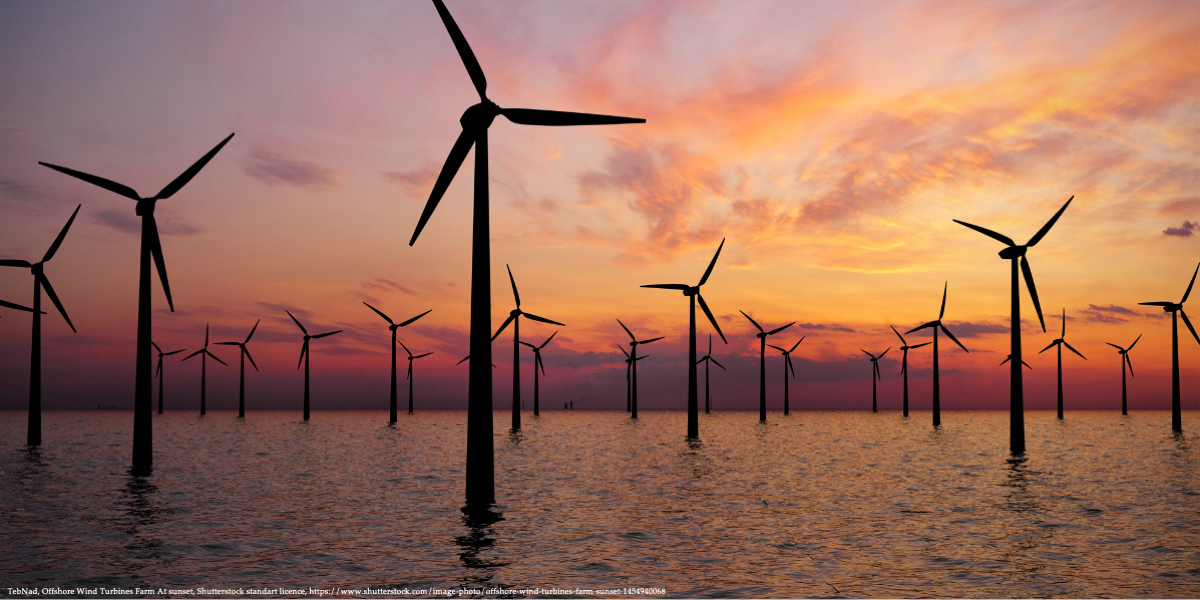
Europe, like other parts of the world, currently grapples with the dual challenges of environmental change and democratic backsliding. In a context marked by rising populism, misinformation, and political manipulation, designing credible sustainable climate policies is more important than ever. The 2024 annual Energy Talk, organized by the Stockholm Institute of Transition Economics (SITE), gathered experts to bring insight into these challenges and explore potential solutions for enhancing green politics.
In the last decades, the EU has taken significant steps to tackle climate change. Yet, there is much to be done to achieve climate neutrality by 2050. The rise of right-wing populists in countries like Italy and Slovakia, and economic priorities that overshadow environmental concerns, such as the pause of environmental regulations in France and reduced gasoline taxes in Sweden, are significantly threatening the green transition. The current political landscape, characterized by democratic backsliding and widespread misinformation, poses severe challenges for maintaining green policy continuity in the EU. The discussions at SITEs Energy Talk 2024 highlighted the need to incorporate resilience into policy design to effectively manage political fluctuations and ensure the sustainability and popular support of environmental policies. This policy brief summarizes the main points from the presentations and discussions.
Policy Sustainability
In his presentation, Michaël Aklin, Associate Professor of Economics and Chair of Policy & Sustainability at the Swiss Federal Institute of Technology in Lausanne, emphasized the need for environmental, economic, and social sustainability into climate policy frameworks. This is particularly important, and challenging given that key sectors of the economy are difficult to decarbonize, such as energy production, transportation, and manufacturing. Additionally, the energy demand in Europe is expected to increase drastically (mainly due to electrification), with supply simultaneously declining (in part due to nuclear power phaseout in several member states, such as Germany). Increasing storage capacity, enhancing demand flexibility, and developing transmission infrastructure all require large, long-term investments, and uncompromising public policy. However, these crucial efforts are at risk due to ongoing political uncertainty. Aklin argued that a politics-resilient climate policy design is essential to avoid market fragmentation, decrease cooperation, and ensure the support for green policies. Currently, industrial policy is seen as the silver bullet, in particular, because it can create economies of scale and ensure political commitment to major projects. However, as Aklin explained, it is not an invincible solution, as such projects may also be undermined by capacity constraints and labour shortages.
Energy Policy Dynamics
Building on Aklin’s insights, Thomas Tangerås, Associate Professor at the Research Institute of Industrial Economics, explored the evolution of Swedish energy policy. Tangerås focused on ongoing shifts in support for nuclear power and renewables, driven by changes in government coalitions. Driven by an ambition to ensure energy security, Sweden historically invested in both hydro and nuclear power stations. In the wake of the Three Mile Island accident, public opinion however shifted and following a referendum in 1980, a nuclear shutdown by 2010 was promised. In the new millennia, the first push for renewables in 2003, was followed by the right-wing government’s nuclear resurgence in 2010, allowing new reactors to replace old ones. In 2016 there was a second renewable push when the left-wing coalition set the goal of 100 percent renewable electricity by 2040 (although with no formal ban on nuclear). This target was however recently reformulated with the election of the right-wing coalition in 2022, which, supported by the far-right party, launched a nuclear renaissance. The revised objective is to achieve 100 percent fossil-free electricity by 2040, with nuclear power playing a crucial role in the clean energy mix.
The back-and-forth energy policy in Sweden has led to high uncertainty. A more consistent policy approach could increase stability and minimize investment risks in the energy sector. Three aspects should be considered to foster a stable and resilient investment climate while mitigating political risks, Tangerås concluded: First, a market-based support system should be established; second, investments must be legally protected, even in the event of policy changes; and third, financial and ownership arrangements must be in place to protect against political expropriation and to facilitate investments, for example, through contractual agreements for advance power sales.
The Path to Net-Zero: A Polish Perspective
Circling back to the need for climate policy to be socially sustainable, Paweł Wróbel, Energy and climate regulatory affairs professional, Founder of GateBrussels, and Managing Director of BalticWind.EU, gave an account of Poland’s recent steps towards the green transition.
Poland is currently on an ambitious path of reaching net-zero, with the new government promising to step up the effort, backing a 90 percent greenhouse gas reduction target for 2040 recently proposed by the EU However, the transition is framed by geopolitical tensions in the region and the subsequent energy security issues as well as high energy prices in the industrial sector. Poland’s green transition is further challenged by social issues given the large share of the population living in coal mining areas (one region, Silesia, accounts for 12 percent of the polish population alone). Still, by 2049, the coal mining is to be phased out and coal in the energy mix is to be phased out even by 2035/2040 – optimistic objectives set by the government in agreement with Polish trade unions.
In order to achieve this, and to facilitate its green transition, Poland has to make use of its large offshore wind potential. This is currently in an exploratory phase and is expected to generate 6 GW by 2030, with a support scheme in place for an addition 12 GW. In addition, progress has been achieved in the adoption of solar power, with prosumers driving the progress in this area. More generally, the private sectors’ share in the energy market is steadily increasing, furthering investments in green technology. However, further investments into storage capacity, transmission, and distribution are crucial as the majority of Polands’ green energy producing regions lie in the north while industries are mainly found in the south.
Paralleling the argument of Aklin, Wróbel also highlighted that Poland’s high industrialization (with about 6 percent of the EU’s industrial production) may slow down the green transition due to the challenges of greening the energy used by this sector. The latter also includes higher energy prices which undermines Poland’s competitiveness on the European market.
Conclusion
The SITE Energy Talk 2024 catalyzed discussions about developing lasting and impactful environmental policies in times of political and economic instability. It also raised questions about how to balance economic growth and climate targets. To achieve its 2050 climate neutrality goals, the EU must implement flexible and sustainable policies supported by strong regulatory and political frameworks – robust enough to withstand economic and political pressures. To ensure democratic processes, it is crucial to address the threat posed by centralised governments decisions, political lock-ins, and large projects (with potential subsequent backlashes). This requires the implementation of fair policies, clearly communicating the benefits of the green transition.
On behalf of the Stockholm Institute of Transition Economics, we would like to thank Michaël Aklin, Thomas Tangerås and Paweł Wróbel for participating in this year’s Energy Talk.
Disclaimer: Opinions expressed in policy briefs and other publications are those of the authors; they do not necessarily reflect those of the FREE Network and its research institutes.
Greening Politics – Navigating Environmental Policy Consistency Amidst Political Change
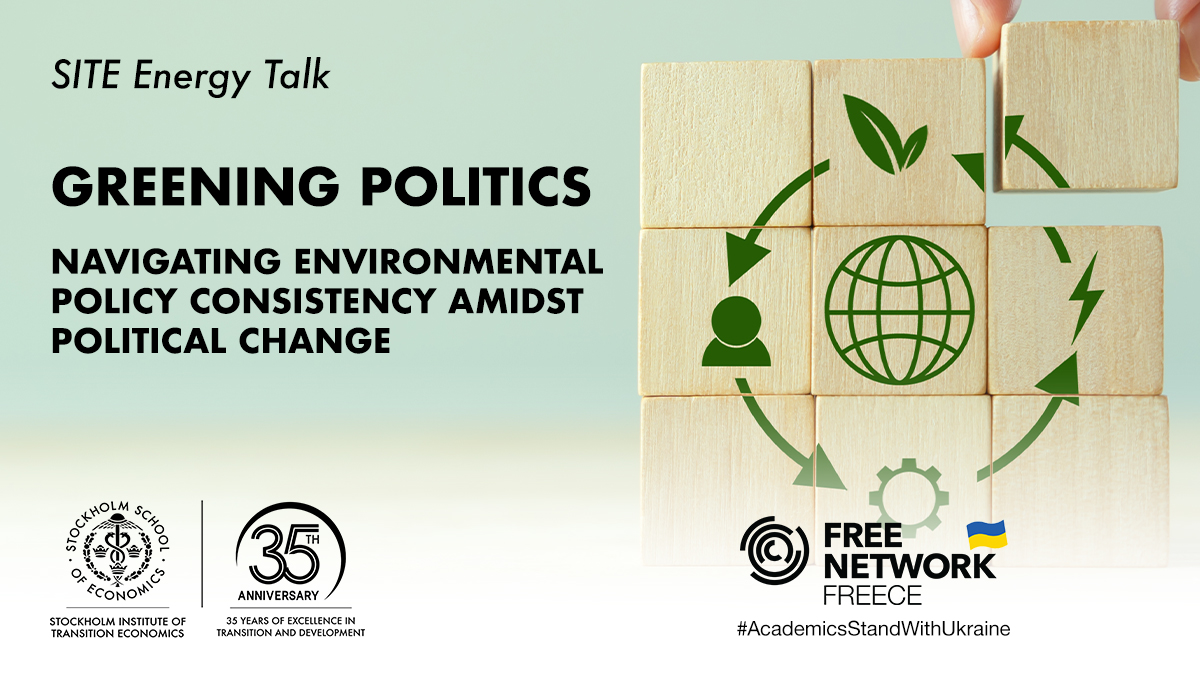
The Stockholm Institute of Transition Economics (SITE) and the Forum for Research on Eastern Europe: Climate and Environment (FREECE) would like to invite you to its 2024 SITE Energy Talk. This edition will address the complexities of upholding environmental policies amidst a changing political landscape.
In the ongoing battle against climate change, maintaining our environmental commitments is more crucial than ever. However, the evolving landscape of global politics, marked by shifting international relations and significant concerns regarding democratic regression, presents escalating challenges to the continuity of our environmental objectives and obligations. This year’s SITE Energy Talk will prioritize the identification of risks posed by political transitions to our environmental aspirations and explore strategies for maintaining the credibility of environmental policies in the face of political flux.
Speakers
Michaël Aklin
Michaël Aklin, Associate Professor of Economics and holder of the Chair of Policy & Sustainability (PASU) at the Swiss Federal Institute of Technology Lausanne, who will offer a broader European perspective.
 Thomas Tangerås
Thomas Tangerås
Thomas Tangerås, Associate Professor, Program Director at the Research Institute of Industrial Economics (IFN), who will address the Swedish perspective on the issue.
Paweł Wróbel
Paweł Wróbel, Energy and climate regulatory affairs professional. Founder of GateBrussels and Managing Director of BalticWind.EU, who will present Polish perspective on green transition in the face of European and regional challenges.
Registration
The event will take place in room Torsten, Sveavägen 65, 113 50 Stockholm (the main building of SSE) and the registration opens at 11.45 near room Torsten.
The event will also be streamed online via Zoom for those who cannot join the event in person. Please register via the Trippus platform:
NOTE: A light lunch will be provided for those who pre-register for in-person participation.
Please contact site@hhs.se if you have any questions regarding the event.
Highlights from Previous SITE Energy Talk Events
SITE Energy Talk is an annual event. The purpose is to bring together scholars and practitioners to discuss recent developments in the energy markets and regulation, such as:
- Energy infrastructure resilience and sustainable future (2023)
- Energy storage: Opportunities and challenges (2021)
- Energy demand management from a behavioral perspective (2018)
- Technological development, geopolitical and environmental issues in our energy future (2017)
- The impact of the technology changes on the energy market (2016)
- Economic impacts of oil price fluctuations (2015)
How to Undermine Russia’s War Capacity: Insights from Development Day 2023
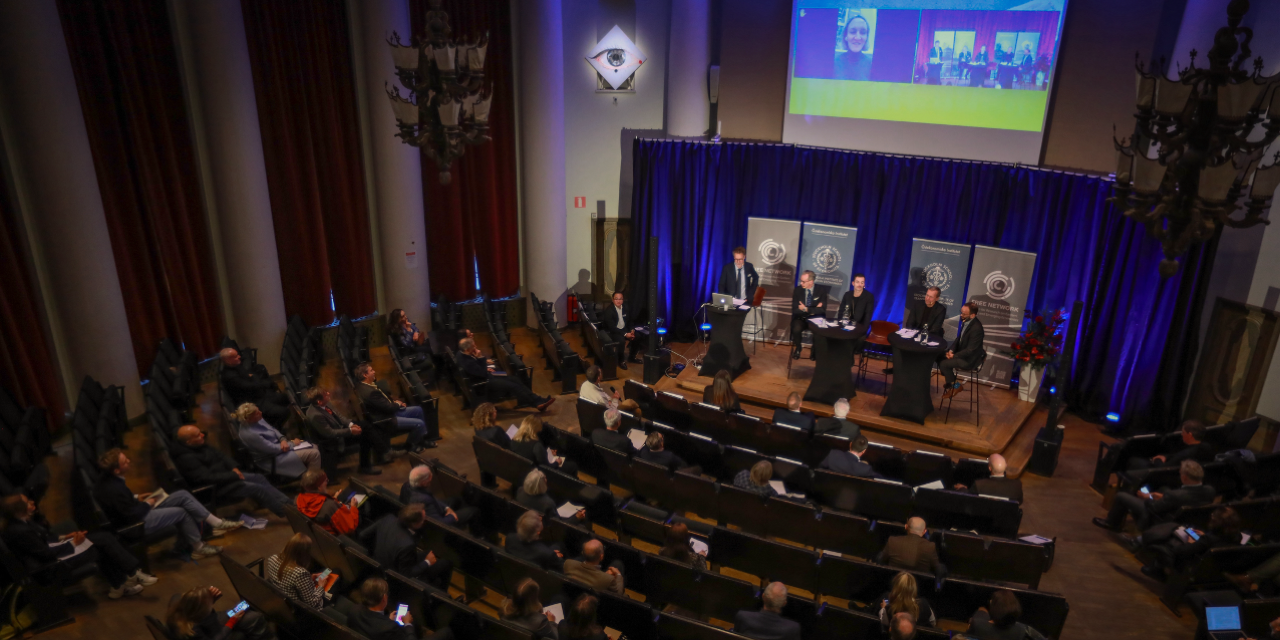
As Russia’s full-scale invasion of Ukraine continues, the future of the country is challenged by wavering Western financial and military support and weak implementation of the sanction’s regime. At the same time, Russia fights an information war, affecting sentiments for Western powers and values across the world. With these challenges in mind, the Stockholm Institute for Transition Economics (SITE) invited researchers and stakeholders to the 2023 Development Day Conference to discuss how to undermine Russia’s capacity to wage war. This policy brief shortly summarizes the featured presentations and discussions.
Holes in the Net of Sanctions
In one of the conference’s initial presentations Aage Borchgrevink (see list at the end of the brief for all presenters’ titles and affiliations) painted a rather dark picture of the current sanctions’ situation. According to Borchgrevink, Europe continuously exports war-critical goods to Russia either via neighboring countries (through re-rerouting), or by tampering with goods’ declaration forms. This claim was supported by Benjamin Hilgenstock who not only showed that technology from multinational companies is found in Russian military equipment but also illustrated (Figure 1) the challenges to export control that come from lengthy production and logistics chains and the various jurisdictions this entails.
Figure 1. Trade flows of war-critical goods, Q1-Q3, 2023.

Source: Benjamin Hilgenstock, Kyiv School of Economics Institute.
Offering a central Asian perspective, Eric Livny highlighted how several of the region’s economies have been booming since the enforcement of sanctions against Russia. According to Livny, European exports to Central Asian countries have in many cases skyrocketed (German exports to the Kyrgyzs Republic have for instance increased by 1000 percent since the invasion), just like exports from Central Asian countries to Russia. Further, most of the export increase from central Asian countries to Russia consists of manufactured goods (such as telephones and computers), machinery and transport equipment – some of which are critical for Russia’s war efforts. Russia has evidently made a major pivot towards Asia, Livny concluded.
This narrative was seconded by Michael Koch, Director at the Swedish National Board of Trade, who pointed to data indicating that several European countries have increased their trade with Russia’s neighboring countries in the wake of the decreased direct exports to Russia. It should be noted, though, that data presented by Borchgrevink showed that the increase in trade from neighboring countries to Russia was substantially smaller than the drop in direct trade with Russia from Europe. This suggests that sanctions still have a substantial impact, albeit smaller than its potential.
According to Koch, a key question is how to make companies more responsible for their business? This was a key theme in the discussion that followed. Offering a Swedish government perspective, Håkan Jevrell emphasized the upcoming adoption of a twelfth sanctions package in the EU, and the importance of previous adopted sanctions’ packages. Jevrell also continued by highlighting the urgency of deferring sanctions circumvention – including analyzing the effect of current sanctions. In the subsequent panel Jevrell, alongside Adrian Sadikovic, Anders Leissner, and Nataliia Shapoval keyed in on sanctions circumvention. The panel discussion brought up the challenges associated with typically complicated sanctions legislation and company ownership structures, urging for more streamlined regulation. Another aspect discussed related to the importance of enforcement of sanctions regulation and the fact that we are yet to see any rulings in relation to sanctions jurisdiction. The panelists agreed that the latter is crucial to deter sanctions violations and to legitimize sanctions and reduce Russian government revenues. Although sanctions have not yet worked as well as hoped for, they still have a bite, (for instance, oil sanctions have decreased Russian oil revenues by 30 percent).
Reducing Russia’s Government Revenues
As was emphasized throughout the conference, fossil fuel export revenues form the backbone of the Russian economy, ultimately allowing for the continuation of the war. Accounting for 40 percent of the federal budget, Russian fossil fuels are currently mainly exported to China and India. However, as presented by Petras Katinas, the EU has since the invasion on the 24th of February, paid 182 billion EUR to Russia for oil and gas imports despite the sanctions. In his presentation, Katinas also highlighted the fact that Liquified Natural Gas (LNG) imports for EU have in fact increased since the invasion – due to sanctions not being in place. The EU/G7 imposed price cap on Russian oil at $60 per barrel was initially effective in reducing Russian export revenues, but its effectiveness has over time being eroded through the emergence of a Russia controlled shadow fleet of tankers and sales documentation fraud. In order to further reduce the Russian government’s income from fossil fuels, Katinas concluded that the whitewashing of Russian oil (i.e., third countries import crude oil, refine it and sell it to sanctioning countries) must be halted, and the price cap on Russian oil needs to be lowered from the current $60 to $30 per barrel.
In his research presentation, Daniel Spiro also focused on oil sanctions targeted towards Russia – what he referred to as the “Energy-economic warfare”. According to Spiro, the sanctions regime should aim at minimizing Russia’s revenues, while at the same time minimizing sanctioning countries’ own costs, keeping in mind that the enemy (i.e. Russia) will act in the exact same way. The sanctions on Russian oil pushes Russia to sell oil to China and India and the effects from this are two-fold: firstly, selling to China and India rather than to the EU implies longer shipping routes and secondly, China and India both get a stronger bargaining position for the price they pay for the Russian oil. As such, the profit margins for Russia have decreased due to the price cap and the longer routes, while India and China are winners – buying at low prices. Considering the potential countermoves, Spiro – much like Katinas – emphasized the need to take control of the tanker market, including insurance, sales and repairs. While the oil price cap has proven potential to be an effective sanction, it has to be coupled with an embargo on LNG and preferrable halted access for Russian ships into European ports – potentially shutting down the Danish strait – Spiro concluded.
Chloé Le Coq presented work on Russian nuclear energy, another energy market where Russia is a dominant player. Russia is currently supplying 12 percent of the United States’ uranium, and accounting for as much as 70 percent on the European market. On top of this, several European countries have Russian-built reactors. While the nuclear-related revenues for Russia today are quite small, the associated political and economic influence is much more prominent. The Russian nuclear energy agency, Rosatom, is building reactors in several countries, locking in technology and offering loans (e.g., Bangladesh has a 20-year commitment in which Rosatom lends 70 percent of the production cost). In this way Russia exerts political influence on the rest of the world. Le Coq argued that energy sanctions should not only be about reducing today’s revenues but also about reducing Russian political and economic influence in the long run.
The notion of choke points for Russian vessels, for instance in the Danish strait, was discussed also in the following panel comprising of Yuliia Pavytska, Iikka Korhonen, Aage Borchgrevink, and Lars Schmidt. The panelists largely agreed that while choke points are potentially a good idea, the focus should be on ensuring that existing sanctions are enforced – noting that sanctions don’t work overnight and the need to avoid sanctions fatigue. Further, the panel discussed the fact that although fossil fuels account for a large chunk of federal revenues, a substantial part of the Russian budget come from profit taxes as well as windfall taxes on select companies, and that Russian state-owned companies should in some form be targeted by sanctions in the future. In line with the previous discussion, the panelists also emphasized the importance of getting banks and companies to cooperate when it comes to sanctions and stay out of the Russian market. Aage Borchgrevink highlighted that for companies to adhere to sanctions legislation they could potentially be criminally charged if they are found violating the sanctions, as it can accrue to human rights violations. For instance, if companies’ parts are used for war crimes, these companies may also be part of such war crimes. As such, sanctions can be regarded as a human rights instrument and companies committing sanctions violations can be prosecuted under criminal law.
Frozen Assets and Disinformation
The topic of Russian influence was discussed also in the conference’s last panel, composed of Anders Ahnlid, Kata Fredheim, Torbjörn Becker, Martin Kragh, and Andrii Plakhotniuk. The panelists discussed Russia’s strong presence on social media platforms and how Russia is posting propaganda at a speed unmet by legislators and left unchecked by tech companies. The strategic narrative televised by Russia claims that Ukraine is not a democracy, and that corruption is rampant – despite the major anti-corruption reforms undertaken since 2014. If the facts are not set straight, the propaganda risks undermining popular support for Ukraine, playing into the hands of Russia. Further, the panelists also discussed the aspect of frozen assets and how the these can be used for rebuilding Ukraine. Thinking long-term, the aim is to modify international law, allowing for confiscation, as there are currently about 200 billion EUR in Russian state-owned assets and about 20 billion EUR worth of private-owned assets, currently frozen.
The panel discussion resonated also in the presentation by Vladyslav Vlasiuk who gave an account of the Ukrainian government’s perspective of the situation. Vlasiuk, much like other speakers, pointed out sanctions as one of the main avenues to stop Russia’s continued war, while also emphasizing the need for research to ensure the implications from sanctions are analyzed and subsequently presented to the public and policy makers alike. Understanding the effects of the sanctions on both Russia’s and the sanctioning countries’ economies is crucial to ensure sustained support for the sanction’s regime, Vlasiuk emphasized.
Joining on video-link from Kyiv, Tymofiy Mylovanov, rounded off the conference by again emphasizing the need for continued pressure on Russia in forms of sanctions and sanctions compliance. According to Mylovanov, the Russian narrative off Ukraine struggling must be countered as the truth is rather that Ukraine is holding up with well-trained troops and high morale. However, Mylovanov continued, future funding of Ukraine’s efforts against Russia must be ensured – reminding the audience how Russia poses a threat not only to Ukraine, but to Europe and the world.
Concluding Remarks
The Russian attack on Ukraine is military and deadly, but the wider attack on the liberal world order, through cyber-attacks, migration flows, propaganda, and disinformation, must also be combatted. As discussed throughout the conference, sanctions have the potential for success, but it hinges on the beliefs and the compliance of citizens, companies, and governments around the world. To have sanctions deliver on their long-term potential it is key to include not only more countries but also the banking sector, and to instill a principled behavior among companies – having them refrain from trading with Russia. Varying degrees of enforcement undermine sanctions compliant countries and companies, ultimately making sanctions less effective. Thus, prosecuting those who breach or purposedly evade sanctions should be a top priority, as well as imposing control over the global tanker market, to regain the initial bite of the oil price cap. Lastly, it is crucial that the global community does not forget about Ukraine in the presence of other conflicts and competing agendas. And to ensure success for Ukraine we need to restrain the Russian war effort through stronger enforcement of sanctions, and by winning the information war.
List of Participants
Anders Ahnlid, Director General at the National Board of Trade
Aage Borchgrevink, Senior Advisor at The Norwegian Helsinki Committee
Torbjörn Becker, Director at the Stockholm Institute of Transition Economics
Chloé Le Coq, Professor of Economics, University of Paris-Panthéon-Assas, Economics and Law Research Center (CRED)
Benjamin Hilgenstock, Senior Economist at Kyiv School of Economics Institute
Håkan Jevrell, State Secretary to the Minister for International Development Cooperation and Foreign Trade
Michael Koch, Director at Swedish National Board of Trade
Iikka Korhonen, Head of the Bank of Finland Institute for Emerging Economies (BOFIT)
Martin Kragh, Deputy Centre Director at Stockholm Centre for Eastern European Studies (SCEEUS)
Eric Livny, Lead Regional Economist for Central Asia at European Bank for Reconstruction and Development (EBRD)
Anders Leissner, Lawyer and Expert on sanctions at Advokatfirman Vinge
Tymofiy Mylovanov, President of the Kyiv School of Economics
Vladyslav Vlasiuk, Sanctions Advisor to the Office of the President of Ukraine
Nataliia Shapoval, Chairman of the Kyiv School of Economics Institute
Yuliia Pavytska, Manager of the Sanctions Programme at KSE Institute
Andrii Plakhotniuk, Ambassador Extraordinary and Plenipotentiary of Ukraine to the Kingdom of Sweden
Daniel Spiro, Associate Professor, Uppsala University
Adrian Sadikovic, Journalist at Dagens Nyheter
Kata Fredheim, Executive Vice President of Partnership and Strategy and Associate Professor at SSE Riga
Lars Schmidt, Director and Sanctions Coordinator at the Ministry for Foreign Affairs, Sweden
Disclaimer: Opinions expressed in policy briefs and other publications are those of the authors; they do not necessarily reflect those of the FREE Network and its research institutes.
How to Undermine the Russian War Effort and Support Ukraine
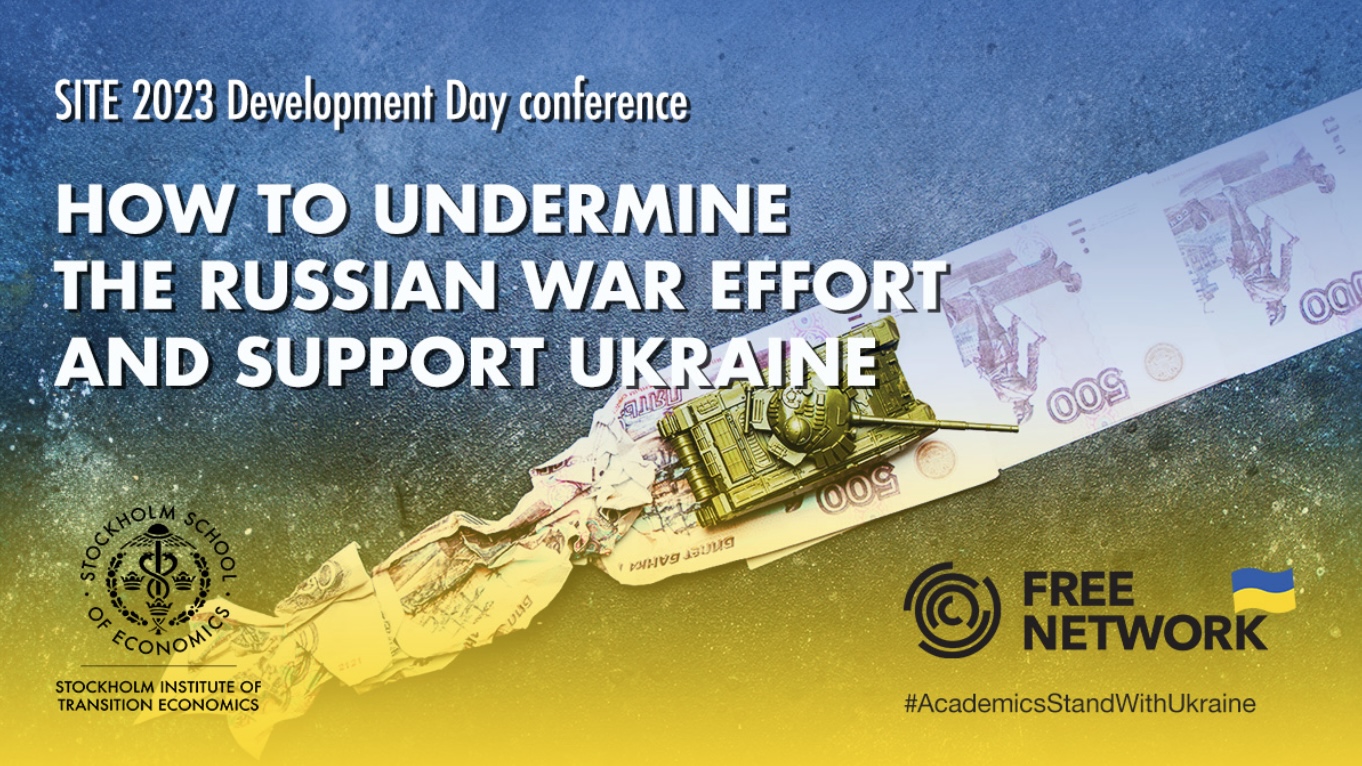
This year SITE’s Development Day will focus on sanctions and other strategies to curb Russian export revenues and the Russian war economy more generally, support Ukraine’s reconstruction efforts, and combat disinformation.
Conference Speakers

Håkan Jevrell, State Secretary to Minister for International Development Cooperation and Foreign Trade Johan Forssell.

Vladyslav Vlasiuk, Sanctions Advisor to the Office of the President of Ukraine and Secretary of the International Expert Group on Russian Sanctions.
Registration & Program
The program will feature both analytical presentations of the current situation and moderated panel discussions. Key topics include the effectiveness of sanctions on Russian energy exports and imports of sanctioned goods from the West, trade and smuggling through neighbouring countries, and sanctions violations of Western companies. The conference will also scrutinize efforts to release frozen Russian assets to contribute to Ukraine’s reconstruction and discuss disinformation and the hybrid war over the medial narrative.
Registration
Please proceed with your registration via the Trippus platform by clicking the following link (see here). If you have any questions regarding the event, please contact site@hhs.se.
Disclaimer: Opinions expressed during events and conferences are those of the authors; they do not necessarily reflect those of the FREE Network and its research institutes.
The Economics of Sustainable Transport

Join us for the workshop on the “Economics of Sustainable Transport” hosted by FREECE and SITE at the Stockholm School of Economics. This one-day event will delve into the complex interplay between transportation systems and environmental sustainability.
Workshop Highlights:
- Paper Presentations: Engage with cutting-edge research on topics such as fuel taxation, air pollution, emission reductions, congestion charges, electric vehicle adoption, tax incidence, and aviation decarbonization.
- Keynote Speeches: Gain insights from leading experts in sustainable transport economics who will share their latest findings and future directions in the field.
Call for Papers:
We invite academics to present their research at the workshop. If you are interested, please submit your paper on topics related to sustainable transport by October 27 to julius.andersson@hhs.se.
Keynote speakers

Thomas Sterner (University of Gothenburg)
Thomas is professor of environmental economics at the University of Gothenburg. His research is focused on the design of environmental policy instruments, and he has published more than 100 academic articles. Recent research focuses on issues of acceptability of policy instruments, their distributional effects, and ways of making efficient instruments such as taxes more acceptable by refunding or using revenues constructively.

Ulrike Kornek (Kiel University)
Ulrike serves as a professor of environmental and resource economics at Kiel University, Germany. Her research interests are in international climate change economics, where she analyzes the design of institution to mitigate climate change, in particular optimal carbon prices, in theoretical and numerical models. Prior to her tenure at Kiel University, she led the Governance group at MCC Berlin.
Why Attend:
- Networking Opportunities: Connect with fellow researchers and practitioners in the field of sustainable transport.
- Latest Research: Stay updated with the newest developments and trends in sustainable transport economics.
- Expert Guidance: Receive valuable feedback and guidance on your research from established experts.
Registration:
Please register for the event by [insert registration link].
Contact Information:
For any questions or further information, please contact julius.andersson@hhs.se.
Registration & Program:
Please proceed with your registration via the Trippus platform by clicking the following link (see here). To see the program please click in the following link (see here). If you have any questions regarding the event, please contact site@hhs.se.
The EU Gas Purchasing Mechanism: A Game-Changer or a Storm in a Teacup?
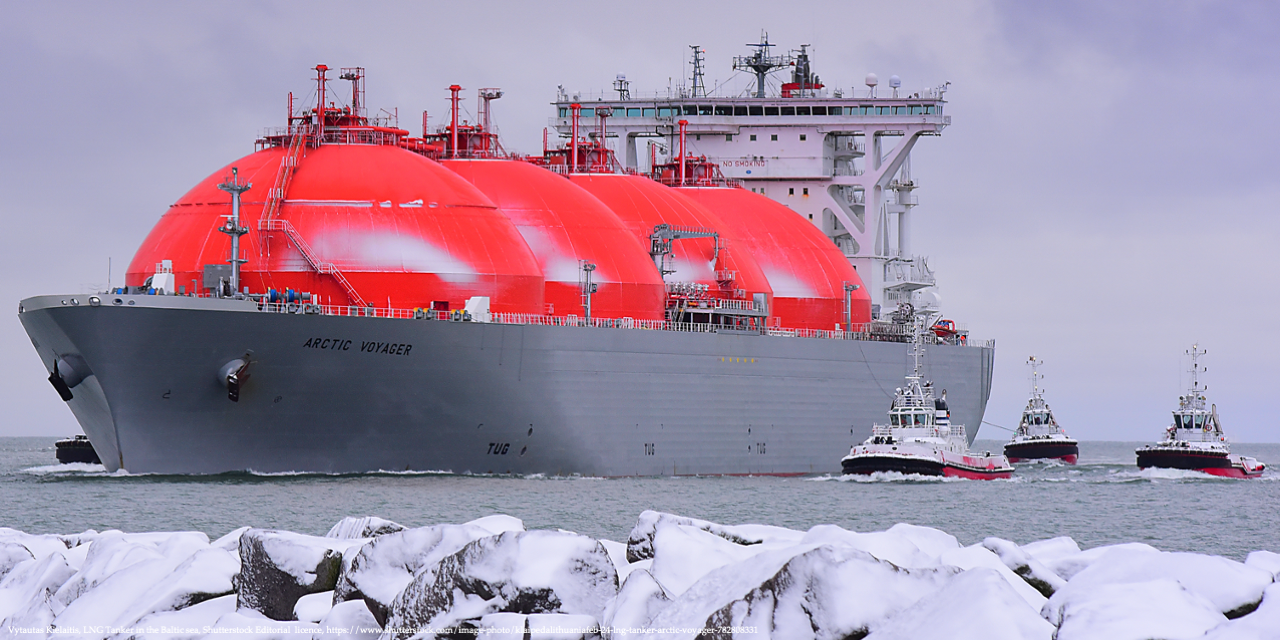
Marking a milestone in the tumultuous journey towards a unified energy policy, the European Union (EU) member states have initiated joint procurement of a portion of their gas consumption. This coordinated effort has been facilitated through a gas purchasing mechanism, the AggregateEU, as of May 2023. In this policy brief we discuss the challenges this mechanism faces, given its design characteristics and the altered dynamics of the gas market following the energy crisis.
The necessity for a coordinated approach to energy security within the EU has been recognized at least since 2009, when its legal base was explicitly introduced in Article 194 of the Treaty of Lisbon. However, the de facto implementation of the solidarity principle has been lagging for many years. In response to the 2022 surge in gas prices, the EU has at last taken the solidarity approach to common energy security seriously. One of the most prominent steps is the creation of the AggregateEU mechanism, launched at the end of 2022. This mechanism aggregates the demand of registered buyers from different member states and matches it with competitive bids from external gas suppliers. It aims at improving and diversifying the EU gas supply, avoiding unnecessary buyer competition within the EU and building up the buyer power of EU member states. Furthermore, the mechanism is meant to reduce uncertainty and mitigate price volatility by providing information about accessible energy supplies. The mechanism covers both pipeline natural gas and Liquified Natural Gas (LNG) and organizes tenders every two months. While EU member states are required to submit demand bids for 15 percent of their 90 percent storage targets for the upcoming 2023-24 season through the mechanism, there is no obligation to sign any contracts based on the resulting match (more details can be found here and here).
The first three rounds of tendering via the mechanism, which took place May-October 2023, matched approximately 34 billion cubic meters of natural gas, exceeding the anticipated initial volumes. This outcome is currently perceived as a great achievement, enabling more vulnerable countries to benefit from coordinated purchases and resulting in increased bargaining power. Driven by this success, the European Commission (EC) has considered making demand aggregation via the mechanism a permanent feature of the EU’s gas market – and even extending it to hydrogen. However, while these agreed trades are a positive development, they may not reflect the mechanism’s overall success. Demand submission obligations may increase the number of demand calls which could project into more matches, but as they are not binding the subsequent agreements may not necessarily result in finalized contracts or lower prices.
In this brief, we argue that the mechanism’s benefits remain uncertain, primarily due to the current state of the EU’s gas market and the design flaws arising from efforts to address disparities in energy security among member states. These considerations call for a direct impact assessment, which however remains impossible due to the EC’s inability (or even reluctancy?) to collect and disclose the contracted outcomes resulting from the mechanism matches. This is especially problematic in light of the EC’s intentions to extend the mechanism’s coverage.
Limited Mechanism Benefits Under New Market Trends
Over the past two years, the EU has undertaken drastic efforts to address the energy security concerns within its gas market caused by the radical reduction in Russia’s natural gas exports to Europe. The EU has managed to sizably improve the diversification of its gas imports (see Figure 1), fill its storage facilities, and lower its gas demand (see McWilliams, Sgaravatti, and Zachmann (2021) and McWilliams and Zachmann (2023)).
Figure 1. Composition of EU natural gas imports.

Source: Authors’ calculations based on McWilliams, Sgaravatti and Zachmann (2021).
As a result, a certain balance of supply and demand has been achieved, and the gas prices in the EU market have fallen to pre-war price levels (though they are still somewhat higher than their earlier long-term trend), as depicted in Figure 2. The ease of market tensions in 2023 has led many to argue that market forces are sufficient to resolve potential problems in the EU gas market and that mechanism costs would not be justified (see, e.g., Eurogas or International Association of Oil and Gas Producers opinions).
However, in the coming years the EU gas market is expected to be relatively tight due to capacity constraints both in the LNG market and for pipeline gas producers (as noted by, e.g., Bloomberg and IEA). This tightness makes the market highly sensitive to shocks, and a twofold increase in exposure to LNG – with its global liquidity – only adds to the problem. A good illustration of this concern is the recent market reaction to the Israel-Palestine war: the fear of supply disruptions lead to a whopping 55 percent increase in the European gas tariff TTF in the second week of October and to an EC initiative to prolong the emergency gas price cap, initially introduced in February 2023. This despite the EU’s gas storage nearing 98 percent of capacity and relatively low current prices.
Such a “seller market” situation implies that buyers’ ability to exercise buyer power and negotiate down prices may be highly limited when needed the most. Specifically, buyer power would be most effective when buyers have a credible outside option, e.g., the ability to claim that their gas demand needs can be facilitated elsewhere. The tighter the market, the more difficult it would be to find such volumes elsewhere, further limiting buyers’ ability to negotiate down prices. To put it differently: current market conditions may undermine the original purpose of the mechanism.
The current “shock-sensitivity” of the gas market may also give rise to additional concerns regarding the mechanism’s mere purpose – demand aggregation for vulnerable buyers. One of the by-products of demand aggregation is that (pooled) buyers are more likely to face correlated risks, e.g., by purchasing gas from the same producer. If markets are highly shock-sensitive – as they currently seem to be – such aggregation may further increase market volatility, implying that vulnerable buyers would be affected the most.
Figure 2. Natural gas prices in the EU, January 2021-October 2023 (prices in EUR).
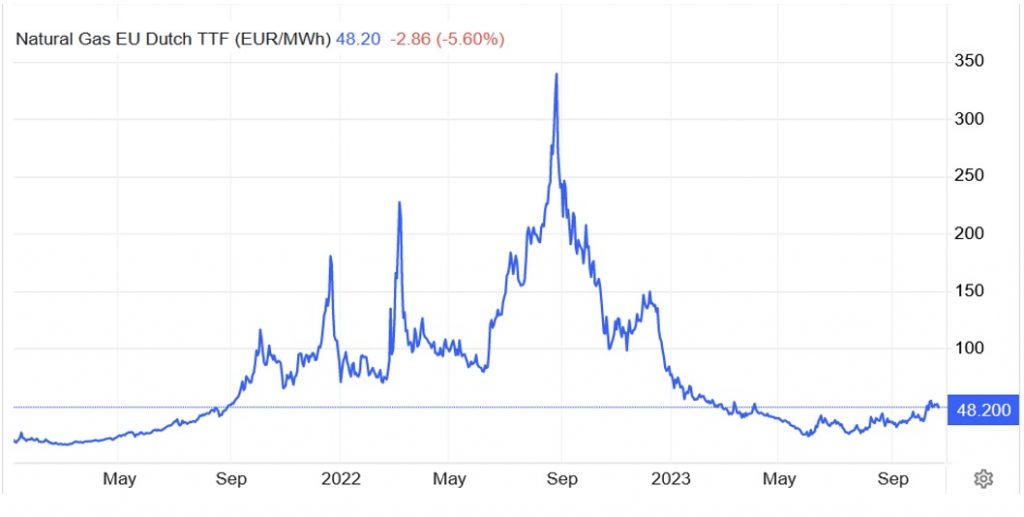
Source: https://tradingeconomics.com/commodity/eu-natural-gas
Mechanism Design: Constraints vs. Efficiency
Some design elements of the purchasing mechanism may also challenge the mechanism’s ability to deliver an efficient outcome. First, quantity and price under the matching process are not binding, and buyers and sellers are expected to continue negotiations individually after the matching. This feature was introduced due to the concern that it would be challenging to offer a “one size fits all” binding contract to incorporate all participants of the pooled demand. This, as argued by Le Coq and Paltseva (2012; 2022), was one of the reasons for the previous failure to implement a mutual insurance and solidarity mechanism across the EU. However, the non-binding matching outcome will likely give rise to re-negotiations, price increases, and failure to exercise consolidated “buyer power”.
Moreover, a company can act on behalf of small or financially constrained buyers, purchase gas for them, and become an “Agent-on-behalf” and “Central Buyer”. In the process, companies will inevitably exchange sensitive information. This may limit competition and increase the market power of the “Central Buyer” company. In addition, firms may choose not to participate in the mechanism for at least two reasons. First, they may fear the threat of revealing valuable private information. Second, demand aggregation may discourage market participants with stronger buyer positions from participating, as being pooled with weaker participants would undermine their bargaining power. Both these cases would create a so-called adverse selection effect, where the more performant market participants would choose to avoid the joint purchasing mechanism. As a result, the joint buyer power may be strongly undermined, and the price-suppressing effect seems uncertain. This may explain why some firms, like several large German firms, have opted to sign long-term contracts with gas suppliers directly rather than via the mechanism
Several of these concerns arise not from the mechanism design per se but rather in combination with the inherent asymmetries between EU buyers, including variations in gas demand, risk exposure, etc. To put it differently: it is well justified that a “one size fits all” approach would fail in ensuring broad (and voluntary) mechanism participation; however, the choice of a more flexible solution, as implemented by the AggregateEU mechanism, creates commitment issues and adverse selection, and may undermine an effective use of buyer power.
Impact Assessment: Necessary but Currently Impossible
The new EU gas purchasing system is a significant step towards creating a unified energy policy. However, the design of such a procurement auction raises concerns about its contribution, especially under the new gas market dynamics. The current low gas prices make the immediate cost-benefit tradeoff of the mechanism nonobvious. More importantly, the tightness of the EU gas market in the next few years makes the “seller” power unlikely to be counteracted by the EU’s buyer power. Further, the absence of legal commitment between matched participants, and increased market volatility can lead to repeated ex-post renegotiations. These elements undermine the mechanism’s role and raise doubts about its benefits. Some of the mechanism’s inherent features, such as incentives for abuse of market power, also contribute to potential efficiency loss.
Hence, while the motivation behind this tool is clear, the implementation and potential design flaws may undermine the gains. It is therefore particularly important to understand whether the mechanism is effectively meeting its objectives, especially given the recent initiative to make it a permanent feature of the EU gas market and a key solution for the European Hydrogen Bank in the future. These considerations make a strong call for an impact assessment. An unbiased measure of AggregateEU’s impact would be necessary to assess the benefits of the mechanism (and to weigh them against the bureaucratic implementation costs). Currently, however, the EC has chosen not to collect, let alone disclose, the contractual outcomes resulting from matches. In a recent interview, Matthew Baldwin, deputy director-general at the EC’s energy directorate, said, “The reality is we’ve had relatively little feedback so far because companies are not required to give that to us in terms of the deals”. One may argue that many of the potential deficiencies of the mechanism design – e.g., non-binding matching and adverse selection – are justified by asymmetries across participants and other inherent market features. However, the absence of (appropriately desensitized) data about actual outcomes resulting from mechanism matches is more difficult to justify. The lack of data prevents us from evaluating the AggregateEU’s performance and raises additional concerns about its efficiency. Thus, gathering relevant information and conducting a comprehensive impact assessment based on sensible criteria are essential prerequisites for the future use, and expansion of the AggregateEU mechanism.
References
- Le Coq, C. and E. Paltseva. (2012). Assessing Gas Transit Risks: Russia vs. the EU, Energy Policy (4), 642-650. https://doi.org/10.1016/j.enpol.2011.12.037
- Le Coq, C. and E. Paltseva. (2022). What does the Gas Crisis Reveal About European Energy Security? FREE Policy Brief, https://freepolicybriefs.org/2022/01/24/gas-crisis-european-energy/
- McWilliams, B., Sgaravatti, G. and G. Zachmann. (2021). ‘European natural gas imports’, Bruegel Datasets. https://www.bruegel.org/publications/datasets/european-natural-gas-imports/
- McWilliams, B. and G. Zachmann. (2023). ‘European natural gas demand tracker’, Bruegel Datasets. https://www.bruegel.org/dataset/european-natural-gas-demand-tracker
Disclaimer: Opinions expressed in policy briefs and other publications are those of the authors; they do not necessarily reflect those of the FREE Network and its research institutes.
Democracy in the Eye of the Beholder?

There is growing concern that democratic institutions in Eastern Europe are fragile. This brief compares two perspectives on the state of democracy: expert assessments and surveys of the general population. We show that while experts’ perception of some countries’ institutions has worsened in recent years, voters are increasingly satisfied with their own democracies. This trend is broad-based, encompassing almost all new EU member states and all age groups. We provide evidence that over time, survey respondents’ assessment of democracy has become more closely tied to the outcome of elections rather than actual institutional change. Where governments have imposed restrictions on media freedom or judicial independence, their supporters continue to report high levels of satisfaction with the way democracy works.
“Across the world, democracy is backsliding”
UN’s Secretary-General António Guterres, 2022
In recent years, the prevailing narrative around democracy in Eastern Europe has been negative. The reform momentum that propelled countries towards EU membership has not been sustained after accession. Discussions of global democratic backsliding frequently cite countries from the region as examples (Grillo and Prato, 2023; Chiopris et al., 2021; Mechkova et al., 2017). Following restrictions on judicial independence and media freedom, some new EU members have seen their ratings slide on indices that measure the quality of democratic institutions based on expert opinions. This brief contrasts these expert assessments with a different perspective on the state of democracy: that of the voters themselves.
Data from Eurobarometer surveys show that satisfaction with ‘the way democracy works in our country’ has been increasing in the new EU member states. This upward trend is visible for all age groups and in almost all countries – including those where experts’ assessment of democracy has worsened. We document patterns in the data that may help to explain this divergence. Survey responses increasingly reflect an instrumentalist view of democracy; respondents who are aligned politically with the winning party are more likely to feel that democracy is working well. This trend can be observed across the EU, but it is most pronounced in the new EU member states where the governing parties are right-of-centre.
Perceptions of Democracy
Expert Assessments
The quality of democracy is hard to measure. A range of indices classify countries by regime type or provide numerical ratings of institutional quality (the Polity, V-Dem, and Freedom House measures are among the most prominent). These indices have somewhat different objectives and methodologies, but they all rely on subjective judgements by expert coders.
Some academic research casts doubt on the prevailing narrative of a global phenomenon of democratic backsliding. For instance, Treisman (2023) and Lueders and Lust (2018) show that there is little consensus across indices, both in terms of individual countries and the global trend. A recent paper by Little and Meng (2023) contrasts subjective indices with more objective indicators of democratic health (e.g. the rate at which incumbents lose elections). The authors find no evidence for global democratic backsliding using the objective measures and suggest that the pessimistic narratives around democracy may have biased coders’ assessment.
There is less disagreement about the development of democracy in Eastern Europe. Treisman (2023) cites Hungary as the only example of a country that has recently been downgraded both from the status of “liberal democracy” by V-Dem and “free state“ by Freedom House. Little and Meng (2023) highlight three cases where both objective and subjective measures indicate backsliding: Hungary and Poland (as well as Venezuela). Further, Becker (2019) shows that downgrades to V-Dem democracy scores in Bulgaria, Czechia, Hungary, Poland, and Romania are relatively broad-based, driven by declines across multiple sub-categories including freedom of expression and constraints on the executive.
Surveys of Public Opinion
We use individual-level data from the Eurobarometer – a survey of public opinion in the EU Member States and candidate countries conducted by the European Commission. The surveys are conducted at an approximately monthly frequency and comprise of a representative sample (about 1000 face-to-face interviews) for each state. We combine data from 42 surveys, spanning 20 years (2002 to 2022), with a total of 1.3 million respondents. The main question we are interested in is: “On the whole are you very satisfied, rather satisfied, not very satisfied or not at all satisfied with the way democracy works in [our country]?”
At the beginning of the sample period in 2002, around a third of respondents in Eastern European EU countries were satisfied with their respective democracies compared to close to twice as many respondents in Western Europe (Figure 1). Over the past 20 years, the share of Eastern Europeans satisfied with their democracy has grown to around 50 percent, narrowing the gap with Western Europe. Figure 2 shows that this pattern is broad based across age groups. All cohorts of Eastern Europeans are more satisfied with democracy than earlier generations and among the youngest respondents, satisfaction is almost as high as in Western Europe.
Figure 1. Satisfaction with Democracy vs V-Dem Score.

Source: Eurobarometer, V-Dem and authors’ calculations.
Figure 2. Satisfaction with Democracy by Age Group.

Notes: Each point shows the sample mean for a single year cohort. 95 percent confidence intervals in grey.
Source: Eurobarometer, authors’ calculations.
Figure 1 also shows a stark divergence in expert assessment of the state of democracy in Eastern Europe compared to public opinion in the same countries. While the V-Dem democracy scores for Eastern Europe have declined rapidly since the mid-2010s, average satisfaction with the own country’s democracy has increased. A much smaller gap between these two measures has also started to open up in Western Europe over the past couple of years.
In Figure 3, we show the same patterns of satisfaction with democracy and expert opinions for individual countries. Satisfaction with one’s own democracy has increased in almost all Eastern European countries, including in Poland and Hungary which at the same time showed the largest declines in democracy scores.
Figure 3. Satisfaction with Democracy vs V-Dem Score by Country.

Source: Eurobarometer, V-Dem and authors’ calculations.
This divergence in individual survey responses and expert assessments is not altogether surprising. First, the Eurobarometer surveys a sample of the population in each country, while V-Dem (and most other similar democracy indices) relies on country experts. Another likely explanation for the difference is the interpretation of the question. Democracy ratings tend to emphasise institutional aspects of a democracy, for instance, the V-Dem liberal democracy index is designed to capture rule of law and checks on executive power (see, e.g., Becker, 2019). In contrast, the survey responses are likely to reflect both satisfaction with the state of democracy in a country, as well as the outcomes of that democracy.
Satisfaction with Democracy and Political Alignment
In this section, we investigate whether stated satisfaction with democracy depends on the outcomes of elections and the political ideology of the respondents. A common way of measuring political ideology is the placement on a right-left scale, where the right favours a free-market economy and traditional values while the left favours economic redistribution and socially progressive policies. We compare the right-left placement of each country’s governing party as coded by the Chapel Hill Expert Survey (CHES), with the self-identified right-left placement of Eurobarometer respondents. We calculate the ideological distance from the government as the absolute difference between these two scores.
Figure 4. Relationship Between Ideological Distance from Government and Satisfaction with Democracy.
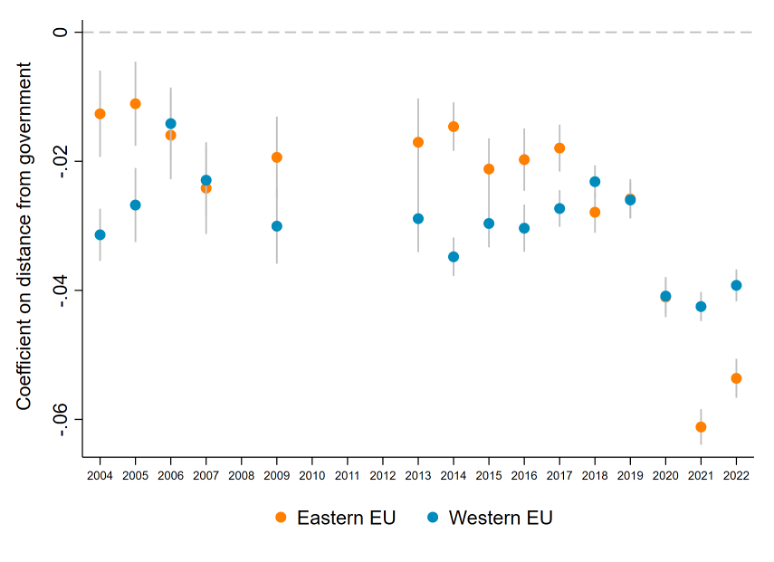
Source: Eurobarometer, Döring, Huber and Manow (2022) and authors’ calculations.
Notes: Each point shows the coefficient from a separate regression of satisfaction with democracy on ideological distance from government, age, gender, year fixed effects and country fixed effects. 95 percent confidence intervals in grey. Coefficient estimates for Eastern and Western EU overlap on the chart for 2019 and 2020.
We find that people are on average less satisfied with their country’s democracy when they are ideologically further from the parties in government (Figure 4). This is consistent with prior evidence (Anderson and Guillory, 1997; Ezrow and Xezonakis, 2011). The alignment effect has become stronger over time – even when taking into account average satisfaction levels for each country and demographic characteristics of the respondents, such as their age and gender. In the past three years, political alignment with the government has become a major factor in explaining satisfaction with democracy, especially in Eastern Europe. Svolik (2019) suggests that voters trade off democratic principles and partisan interests. As political polarisation increases, voters become more willing to accept a government that undermines democratic institutions, as long as it is on ‘their side’ ideologically.
Figure 5. Satisfaction with Democracy and Political Ideology. Western Europe in the Left Panel and Eastern Europe in the Right Panel.
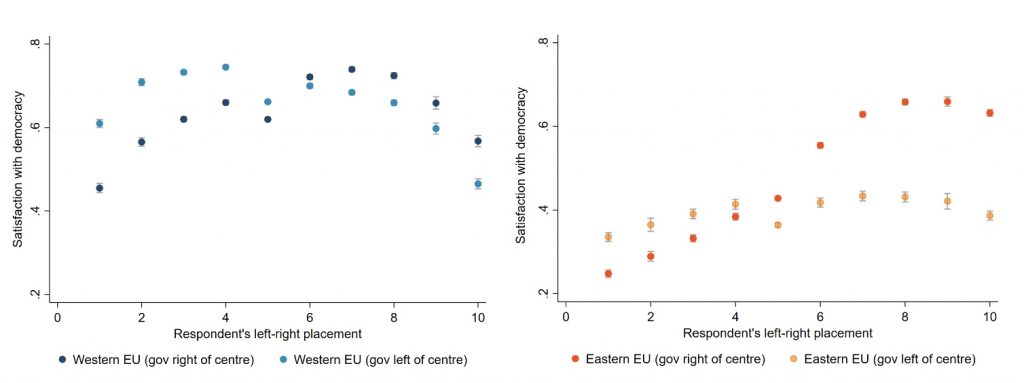
Source: Eurobarometer, Döring, Huber and Manow (2022) and authors’ calculations.
Notes: Respondents with the most left-leaning ideology are at the extreme left of the x-axis, those with the most right-leaning ideology are at the extreme right. The sample covers the period 2002 to 2022 and excludes observations where the government is coded as centrist (scores of 5-6 in the CHES data). 95 percent confidence intervals in grey.
In Figure 5, we break down the effect of political alignment on satisfaction with democracy according to individuals’ political leanings. On the x-axis is the respondents’ left-right placement and on the y-axis there are two series of dots showing satisfaction with democracy depending on whether the government is left of centre (lighter coloured dots) or right of centre (darker coloured dots). As before, being politically aligned with the government increases satisfaction, that is, to the left of the chart, the lighter coloured dots are placed higher than the darker coloured dots and vice versa for the right of the chart. The further from centre a person’s political leanings, the less satisfied they are with a government of the opposite ideology. There is also some evidence of asymmetry across the political spectrum in Eastern Europe, with respondents on the political right reporting much higher levels of satisfaction with right-wing governments compared to voters on the left under a left-wing government.
Conclusion
Over the past decade, there has been increasing concern over democratic backsliding in some of the Eastern European countries that are members of the EU. This is reflected in commonly used democracy indices whose country experts note the worrying trends in countries’ institutions – such as the reduction of freedom of expression, the strengthening of rule of law and constraints on the executive, all hallmarks of a liberal democracy. In this policy brief, we investigate whether this erosion of institutional safeguards affects people’s stated satisfaction with democracy in one’s respective country. We find a broad-based increase in satisfaction with democracy in the Eastern European EU countries, including in the countries that have seen some of the largest declines in liberal democracy ratings. We show that stated satisfaction with democracy reflects less the institutional changes in countries, but more the outcome of democratic elections. Voters who are politically aligned with their government are systematically more likely to report that they are satisfied with the state of democracy in their country. And this effect has become stronger in the most recent years, particularly in the Eastern European EU countries. We also find that this effect is not symmetric across the political spectrum. In the Eastern European EU countries, respondents on the political right are more satisfied with right-wing governments than those on the left are with left-wing governments.
The descriptive patterns outlined in this policy brief illustrate a worrying disconnect in the minds of many voters between institutions and outcomes of the democratic process. The threat of democratic backsliding in Europe and across the globe is predominantly not due to electoral democracies being replaced by autocratic regimes. Rather, genuinely popular (and often populist) governments are democratically elected and, once in power, proceed to undermine and dismantle liberal democratic institutions, such as a free press, an independent judiciary, and a fair electoral system. This process in turn makes it more difficult for opposition parties to win future elections, further cementing the power of the rulers of these illiberal democracies. While the electorate might support these governments now, voters need to be aware that these liberal institutions are designed to safeguard their democratic future.
References
- Anderson, C. J. and Guillory, C. A. (1997). Political institutions and satisfaction with democracy: A cross-national analysis of consensus and majoritarian systems. American Political Science Review, 91(1), pp.66-81.
- Becker, T. (2019). Liberal Democracy in Transition – The First 30 Years. FREE Policy Brief.
- Chiopris, C., Nalepa, M. and Vanberg, G. (2021). A wolf in sheep’s clothing: Citizen uncertainty and democratic backsliding. Working Paper.
- Döring, H., Huber, C. and Manow, P. (2022). ParlGov 2022 Release. Harvard Dataverse. https://doi.org/10.7910/DVN/UKILBE
- Eurobarometer (multiple waves: 2002-2022), European Commission. Brussels
- Ezrow, L. and Xezonakis, G. (2011). Citizen satisfaction with democracy and parties’ policy offerings. Comparative Political Studies, 44(9), pp.1152-1178.
- Grillo, E. and Prato, C. (2023). Reference points and democratic backsliding. American Journal of Political Science, 67(1), pp.71-88.
- Little, A. and Meng, A. (2023). Subjective and Objective Measurement of Democratic Backsliding. Available at SSRN 4327307.
- Lueders, H. and Lust, E. (2018). Multiple measurements, elusive agreement, and unstable outcomes in the study of regime change. The Journal of Politics, 80(2), pp.736-741.
- Mechkova, V., Luhrmann, A. and Lindberg, S. I. (2017). How much democratic backsliding?. Journal of. Democracy, 28, pp.162-169.
- Svolik, M. W. (2019). Polarization versus democracy. Journal of Democracy, 30(3), pp.20-32.
- Treisman, D. (2023). How great is the current danger to democracy? assessing the risk with historical data. Comparative Political Studies, https://doi.org/10.1177/00104140231168363.
Disclaimer: Opinions expressed in policy briefs and other publications are those of the authors; they do not necessarily reflect those of the FREE Network and its research institutes.


